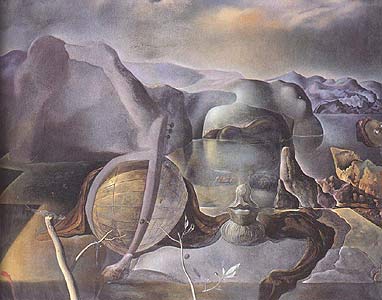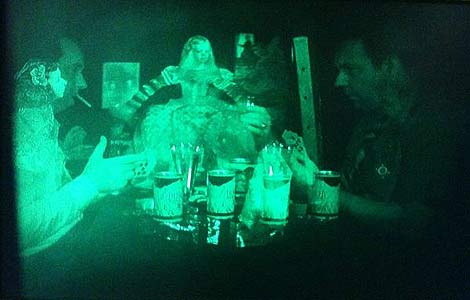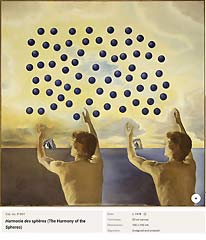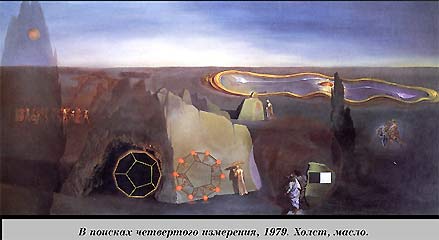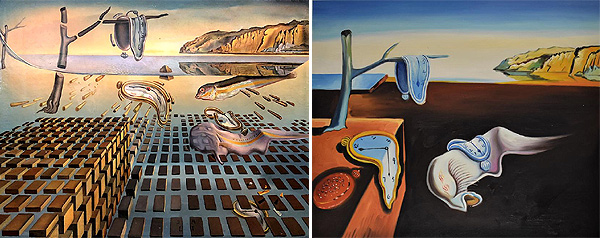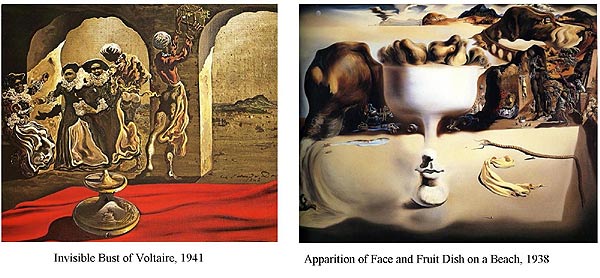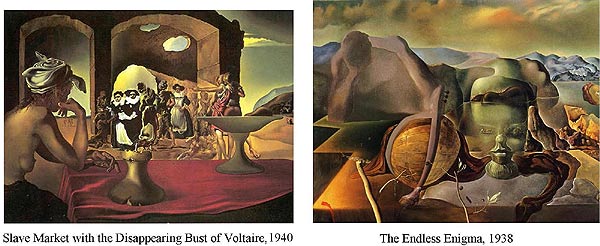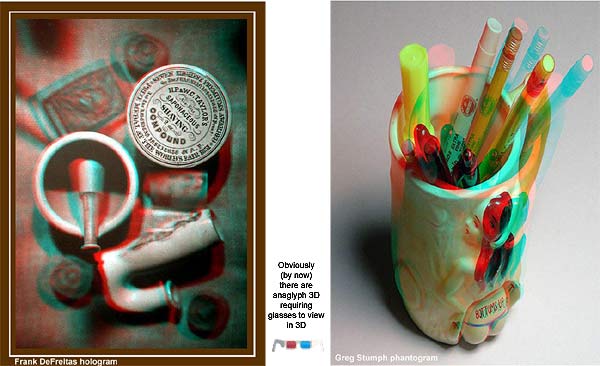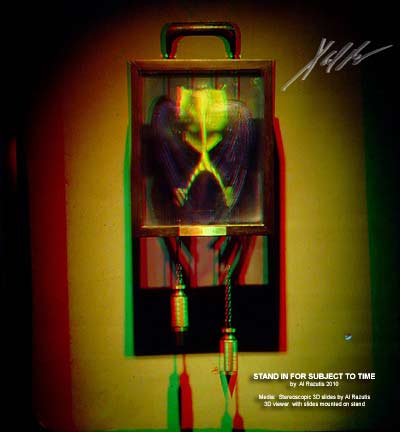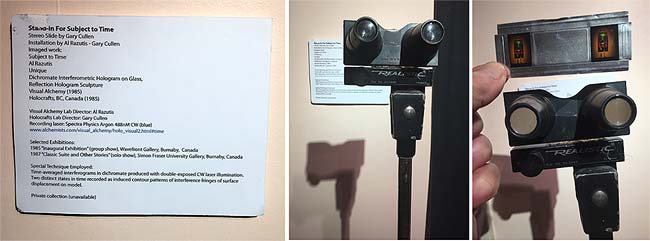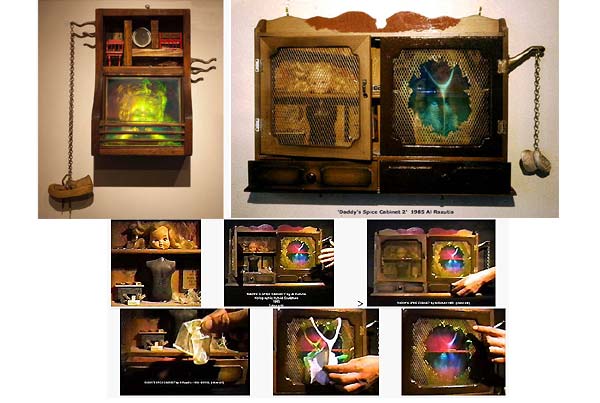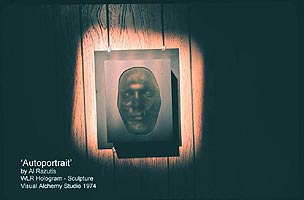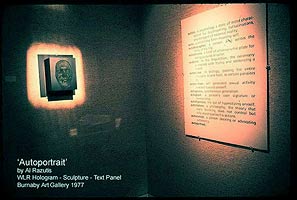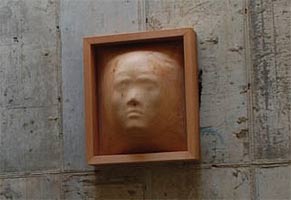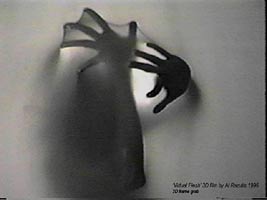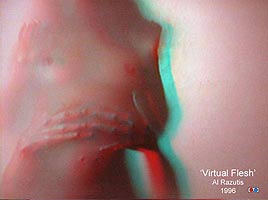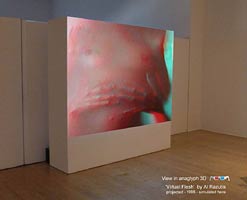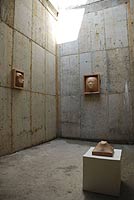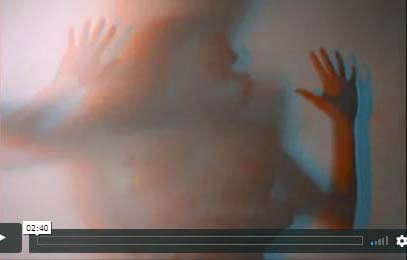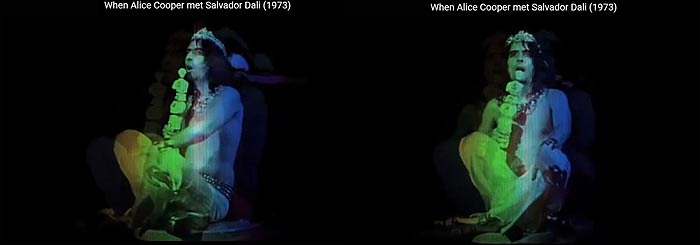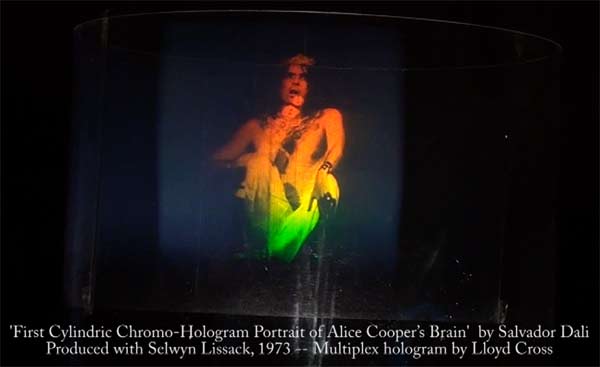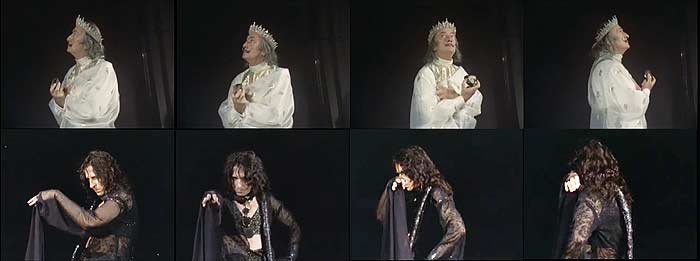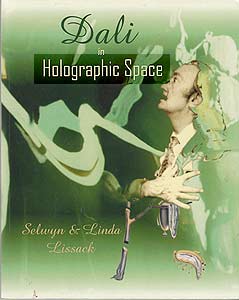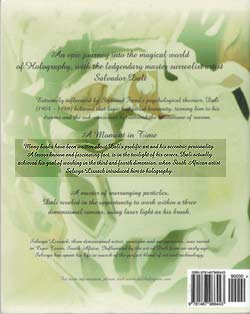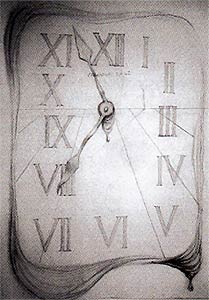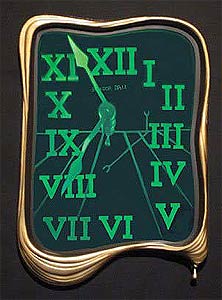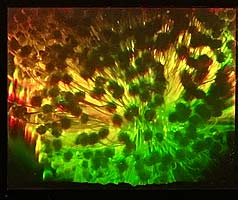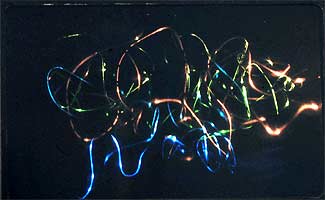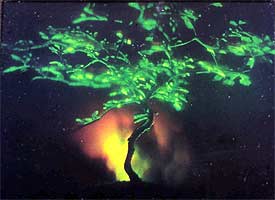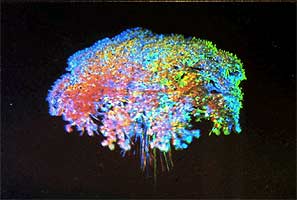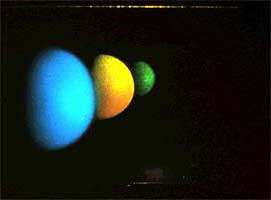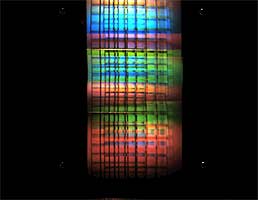3D or not 3D? 'Dalinian Stereo and Holographic Space'
Al Razutis 2021

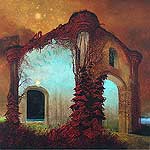

Stereo photo of Salvador Dali by Marc Lacroix --- painting by Zdzislaw Beksinski --- hologram by Salvador Dali
QUICK LINKS TO:
'The idea' 'The method' 'The world' 'The art' 'Spacetime' 'Symmetry' 'Holographic space' 'Holograms' 'Dissection' 'Alchemy' 'Zoo stories' 'About time?' 'Melting clock' 'Not a Dali?'
INTRODUCTION
by Al Razutis
Stereoscopic 3D art and holographic art are a natural relation. I've danced with this pair of representing the way we see (and what we see) for decades, have web pages dedicated to that dance since the days of the last century: http://www.alchemists.com/visual_alchemy/3d_video.html
What continues to amaze me is how we re-discover this connection, like I recently redicsovered Stereoscopic 3D art (paintings - in stereopairs) by Salvador Dali, a magnificent painter of surrealism, who went commercial, experimented, proclaimed himself and his art in hyperbole, and said f-off to the purists or anyone who might interfere with his paranoid (and sometimes schizoid) positions.
I rediscovered Dali's stereo paintings, am studying them to inform me of his intentions towards 'space' and holography, and I do this in spite of some real trash out there on the subjects in the holo community, and I do this with respect for his work and his Dali museums and their collections.
'Las Meninas' - two stereoscopic paintings - Salvador Dali
Left: stereoscopic (paired) paintings oil on canvas -- Right: color anaglyph stereo 3D view of 'Las Meninas' painting
(anaglyph recostructed by A.R.)

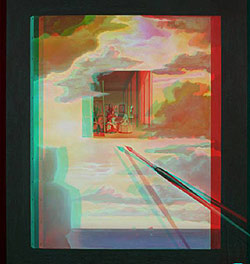
If you know art, you know who Dali is and can search to your heart's content. If you know holographic art, you know what Al (speaking third person) said in his findings on Dali and holography, like for example on the web page and section 'Being Dali' at http://www.alchemists.com/visual_alchemy/how_much_holo.html#dali
This essay begins with Dali and his stereoscopic paintings, some history and thoughts on this subject. I'll then re-investigate the connection to his holographic work, particularly 'Dali Paints Gala', a 360 degree multiplex hologram which was realized holographically (printed) by Lloyd Cross and which resides in the Sharon McCormack Collection & Archives at Visual Alchemy since 2016.
I prefer to begin the introduction with Dali and end it with Dali, for the reason that Dali's work is both a great example of experimenting with perception and because it deals with 'inner' and 'outer' concepts and representations of 'space' like few other artists could, and because some of it is most problematic.
He was a surrealist, part of a movement of artists experimentalists who visited Freud, Marx, and all the other European topics of the early 20th century with a zest and committment that few others showed.
Dali's surrealist paintings are known world over. Less known is his work in what we call 'stereoscopic 3D paintings' (beginning in 1965 to the end of the 70's), and several experimental works in holography and holographic imaging which he completed in the 1970's as well. Dali's paintings in stereo 3D, where a 'left canvas' and 'right canvas' are painted to correspond to the 3D 'stereoscopic bicameral views' are a combination of content derived from a stereoscopic 3D camera view (photos) and the inventions in his mind of what constituted (as he called it) 'Dalinian Space'.
When dealing with 'Dalinian Space' or Dali's stereoscopic paintings, one can assume that there will be intentional disparities between what would be normally seen in a left and right 'stereoscopic view'. We can make this assumption because Dali constantly experimented with, and wilfully defied the 'rational' in favor of pushing his artistic boundaries in whichever media he chose.
Even less known are the few holograms that he created in the 1970's. We will get to some of those 'disasters' after viewing, examining Dali's paintings.
One can immediately assume that Dali's 'space' is both representative (of the outside world) and subjective (of his own mental space) and ' represents a tension and paradoxes when one perceives the outer and inner, as was the 'surrealist thing'. (See quotes by Dali and Max Ernst on this subject below.)
In the hands of an artist this approach to stereoscopic composition takes a 'wild turn'. Nothing normal here, not trying to be 'tech savvy' or 'perfect'. Flaws, mistakes, and purposeful contradictions (between left and right eye views) is "what this art takes".
We can examine in Dali's career examples of paintings, then holograms to get a better idea of what 'Dalinian Space' was and how and why he went 'holographic' in his later experiments. These later projects were ultimately compromised by incompetent helpers, promoters, parasitic elements who were trying to create something of which they had little understanding of, namely either 'Dalinian Space' or 'Holographic Space', but on which they pompously commented on and tried to make money off of it." (A.R.)
1.0 'The surrealist idea...'
The surrealist idea was to alter and mess with reality not faithfully reproduce it
|
Quotes from Dali and Ernst regarding surrealism, paranoia, irrationality, inspiration and vision: "Concrete models of irrationality" -- Dali joins the surrealists to coincide with this phase of surrealism. "Paranoia makes use of the external world... The external world serves as an illustration placed at the service of the mind's reality." -- Salvador Dali "Active paranoic thought will make it possible to systematize confusion and contribute to the total discrediting of the world of reality" -- Salvador Dali "I believe the best to do is to have one eye closed and to look inside... with the other eye have it fixed on reality and what is going on in the world... if you can make a synthesis of these important worlds... synthesis of subjective and objective life." -- Max Ernst |
And there is a good way to illustrate the inner outer vision and world (painting by Zdzislaw Beksinski)
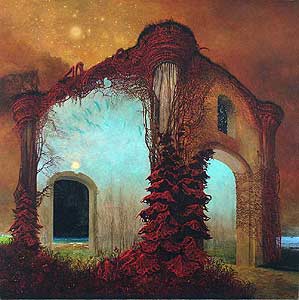
"This and the surrealist 'concrete models of irrationality' makes for a great stew of ideas in approaching Dali's works in 3D..." (A.R.)
------------- Page Top -------------
2.0 Dali's Paranoiac-Critical Method, optical illusions, splitting
"The paranoiac-critical method is a surrealist technique developed by Salvador Dalí in the early 1930s. He employed it in the production of paintings and other artworks, especially those that involved optical illusions and other multiple images. The technique consists of the artist invoking a paranoid state (fear that the self is being manipulated, targeted or controlled by others). The result is a deconstruction of the psychological concept of identity, such that subjectivity becomes the primary aspect of the artwork." (Wiki)
Dali's Paranoiac-Critical Paintings

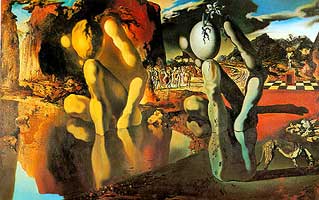
'Invisible Bust of Voltaire' and 'Apparition of Face and Fruit Dish on a Beach' and 'The Metamorphosis of Narcissus'

'Suburbs of a Paranoiac Critical Town, Afternoon on the Outskirts of European History' by Salvador Dali 1936
EXCELLENT RESOURCE FOR DALI'S PARANOIC CRITICAL METHOD AND WRITINGS & SURREALISM:
'Exploring the irrational: The paranoiac- critical method of Salvador Dali'
2.1 What is the mind that contemplates wholeness from the disintegration of subject?
To answer is to engage the profundity of Dali's initial explorations of double image, splitting, optical illusions and stereoscopy, then his interests in recombining through metaphor, though rarely in fact, the holographic space time that remains elusive to most. And that's not an easy task, but requires a life-time.
The following selected quotes plus illustrations are excerpted from 'Exploring the irrational: The paranoiac- critical method of Salvador Dali' by Chris Tselentis, which contains a remarkably broad and insightful survey of Dali's works in these related topics.
Dali extensively talks about his paranoiac - critical method in his 1930 essay 'The Rotting Donkey:'
|
"An activity having a moral tendency could be provoked by the violently paranoiac will to systematize confusion. "The very fact of paranoia, and, in particular, consideration of its mechanism as a force and power, lead us to the possibility of a mental crisis, perhaps of an equivalent nature, but in any case at the opposite pole from the crisis to which we are also subjected by the fact of hallucination. "I believe the moment is drawing near when, by a thought process of a paranoiac and active character, it would be possible (simultaneously with automatism and other passive states) to systematize confusion and thereby contribute to a total discrediting of the world of reality. "The new simulacra which the paranoiac thought may suddenly let loose will not merely have their origin in the unconscious, but, in addition, the force of the paranoiac power will itself be at the service of the unconscious. ( ... ) "Standing wholly apart from the influence of the sensory phenomena with which hallucination is more or less taken to be associated, the paranoiac activity always makes use of materials that are controllable and recognizable. Suffice it that the delirium of interpretation should have linked together the sense of the images of heterogeneous pictures covering a wall for the real existence of this link to be no longer deniable. Paranoia makes use or the external world in order to set off its obsessive idea, with the disturbing characteristic of verifying the reality of this idea for others. The reality of the external world serves as an illustration and proof, and is placed thus at the service of the reality of our mind. ( ... ) "It is by a distinctly paranoiac process that it has been possible to obtain a double image: in other words, a representation of an object that is also, without the slightest pictorial or anatomical modification, the representation of another entirely different object, this one being equally devoid of any deformation or abnormality disclosing some adjustment. "The attainment of such a double image has been made possible thanks to the violence of the paranoiac thought which has made use, with cunning and skill, of the required quantity of pretexts, coincidences, and so on, taking advantage of them so as to reveal the second image, which, in this case, supersedes the obsessive idea. "The double image (an example of which might be the image of a horse that is at the same time the image of a woman) may be extended, continuing the paranoiac process, with the existence of another obsessive idea being sufficient for the emergence of a third image (the image of a lion, for example) and thus in succession until the concurrence of a number of images which would be limited only by the extent of the mind’s paranoiac capacity. "I submit to a materialist analysis the type of mental crisis that might be provoked by such an image; I submit to it the far more complex problem of determining which of these images has the highest potential for existence, once the intervention of desire is accepted; and also the more serious and general question whether a series of such representations accepts a limit, or, whether, as we have every reason to believe, such a limit does not exist, or exists merely as a function of each individual's paranoiac capacity. "All this (assuming that no other general causes intervene) allows me, to say the least, to contend that our images of reality themselves depend on the degree of our paranoiac faculty, and that yet, theoretically, an individual endowed with a sufficient degree of this faculty, might as he wishes see the successive changes of form of an object perceived in reality, just as in the case of voluntary hallucination; this, however, with the still more devastatingly important characteristic that the various forms assumed by the object in question will be controllable and recognizable by all, as soon as the paranoiac will simply indicate them. "The paranoiac mechanism giving birth to the image of multiple figuration endows our understanding with a key to the birth and origin of the essence of the simulacra, whose furor dominates the aspect under which are hidden the multiple appearances of the concrete. It is precisely the violence and the traumatic essence of the simulacra with regard to reality, and the absence of the slightest osmosis between reality and the simulacra, which lead us to infer the (poetic) impossibility of any kind of comparison. There would be no possibility of comparing two things, unless it would be possible for them to exist with no links whatsoever, conscious or unconscious, between them. Such a comparison made tangible would clearly serve as illustration of our notion of the gratuitous. "It is by their lack of congruity with reality, and for what may be seen as gratuitous in their existence, that the simulacra so easily assume the form of reality while the latter, in its turn, may adapt itself to the violence of the simulacra, which materialist thought idiotically confounds with the violence of reality. "Nothing can prevent me from recognizing the multiple presence of simulacra in the example of the multiple image, even if one of its states adopts the appearance of a rotting donkey and even if such a donkey is actually and horribly putrefied, covered with thousands of flies and ants; and, since in this case one cannot infer the meaning of these distinct states of the image beyond the notion of time, nothing can convince me that this merciless putrefaction of the donkey is anything other than the hard and blinding glint of new precious stones. ( ... ) "The acceptance of simulacra, whose appearances reality strives with great difficulty to imitate, leads us to desire real things. ( ... ) "The new images, as a functional form of thought, will adopt the free disposition of desire while being violently repressed. The lethal activity of these new images, simultaneously with other Surrealist activities, may also contribute to the collapse of reality, to the benefit of everything which, through and beyond the base and abominable ideals of any kind, aesthetic, humanitarian, philosophical, and soon, brings us back to the clear sources of masturbation, of exhibitionism, of crime and of love. " Excerpted from 'Exploring the irrational: The paranoiac- critical method of Salvador Dali' by Chris Tselentis |
In reference to 'mirror image' and 'splitting'
The author's (A.R.) visual essay on Un Chien Andalou by Dali and Bunuel (1929) and other surrealist mayhem is titled "Ghost : Image"
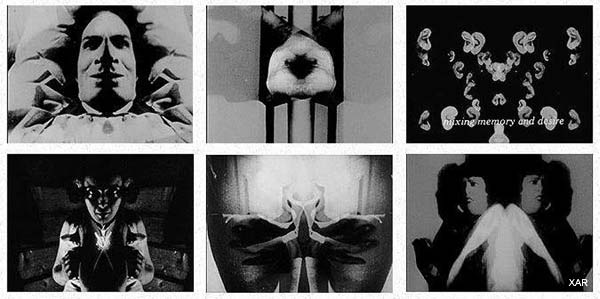
" And from there, and in light of there, we can explore the Dalinian 'Paranoiac - Critical Method' and its assault on oppressive 'reality' which Dali and the surrealists were intent on unseating from its prominence in culture and because of the world war it had spawned.
"The surrealist agenda included a political agenda, a revolutionary agenda. This was not an art of the fashionistas, the glam crowd, the impersonators, though later on it becamse 'assimilated into late capitalism' like all the situationists knew would happen.
"So, on the subject of 'splitting' and 'paranoiacs' and their use of perception and language (to include the 'automatic writing' kind) I refer to a Visual Essay (#4) titled "Ghost : Image", to convery in motion pictures what some of this surrealism had in mind, and what happened to it when it became assimilated in 'horror film genre'..." --- Al Razutis 2021
http://www.alchemists.com/visual_alchemy/film_visess.html#ghost
"It's clear that the Rorschach 'method' can reveal what a paranoiac may have missed... I'll leave that to the analysts, because artists (surrealists) surely didn't need an explanation of what constitutes that marvelous 'other' that is created in this stew." (A.R.)
-------------------------------------------------------
'The paranoiac-critical method'
"The paranoiac-critical method of Dali is an effort to systematize irrational thought. The 'shock,' which the surrealistic movement had been searching for in order to shatter common logic, was implemented by Dali with his double images, and with paintings which had more than one 'interpretations'."
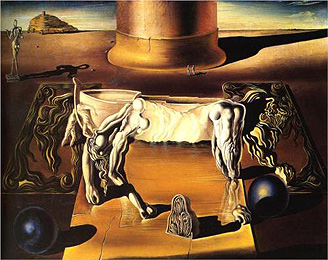
'Paranoiac Woman-Horse (Invisible Sleeping Woman, Lion, Horse, 1930)' by Dali
Excellent resource:
https://tothelandofdreams.blogspot.com/2018/05/exploring-irrational-paranoiac-critical.html
-------------------------------------------------------
|
MORE USEFUL RESOURCES: 'Europe After The Rain', a film by Mick Gold, 1978 Movie on you tube: https://www.youtube.com/watch?v=sdBaS8fgwNs Quotes and Summaries "The birth of Dada was not the beginning of art but of disgust." -- Tristan Tzara "Dada was a bomb. We, the Dadaist exploded this bomb. The fragments have scattered across the world. What are the museums doing? They are trying to reassemble those fragments to exhibit to the public as relics." -- Max Ernst "Surrealism tried to systematize Dada's anarchy into an artistic blend of Freudian psychoanalysis and Marxist provocation. In the interests of conquering the irrational, Salvador Dali opened exhibitions dressed in a diving suit, Marcel Duchamp turned himself into woman, Benjamin Peret assaulted priests, and Yves Tanguy ate spiders. Andre Breton, nicknamed 'the Pope of Surrealism', led an inspired gang of artists, lunatics and writers. "By the 1950s they were denouncing each other for betraying the movement, but their ideas had infected Hollywood, advertising agencies and were turning up as TV humor and album covers."
|
------------- Page Top -------------
3.0 The Dalinian World out there
A paranoid splitting leads to stereo painting to holography
|
"The 1930s were marked by an interest in dual images and optical illusions, interests that Dalí never left aside in his works. The first dual image he painted was The Invisible Man, 1929. Other examples are: Invisible Sleeper, Horse, Lion, 1930; Paranoic Face, 1935; Spain, 1937 and The Endless Enigma, 1938."
"But it was during the period 1962-1978 that we can state with assurance that his work was truly influenced by the impact of science. The first part focused above all on genetics, and more specifically on DNA and its structure. We have an example in the work Galacidalacidesoxyribonucleicacid dating from 1963. In 1965 his interest in holography and three-dimensional art began toawaken Over the course of the decade he continued to study this latter aspect and the work of Gerard Dou, in whose canvases he discovered dual images, that is, stereoscopic images. From that timehe began to work with a Fresnel lens in order to put together these images. In 1971, when Denis Gabor was awarded the Nobel Prize for his work on lasers, Salvador Dalí was interested in holography and in 1972 hosted his first hologram exhibition at the prestigious Knoedler Gallery in New York, where the hologram Holos! Holos! Velázquez! Gabor! was presented (this hologram was also presented at the Dalí-Theatre-Museum)."
"From the 1970s we can highlight the following works, all of them stereoscopic: Dalí from the Back Painting Gala from the Back Eternalised by Six Virtual Corneas Provisionally Reflected in Six Real Mirrors, 1972-73
"... Dalí Lifting the Skin of the Mediterranean to show Gala the Birth of Venus, 1977; Dali's Hand Drawing Back a Golden Fleece to Show Gala the Naked Dawn Very, Very Far Away Behind the Sun, 1977. Other important works are The Harmony of the Spheres, a stereoscopic work in a single element, and In Search of the Fourth Dimension, 1979."
'Salvador Dalí and science', Carme Ruiz
|
A critical NOTE: "It is interesting that in this survey of Dali and 3D and holography by the Centre of Dalinian Studies and the Gala - Salvador Dali Foundation curator and scholar Carme Ruiz, and written in 2000, there is no mention of Dali 'multiplex holograms' made in the 1970's (as documented extensively in my writings) and and no mention of Selwyn Lissack who wrote a book claiming that he made them in 'collaboration with Dali' and has been selling some in an art auction house -- I hope the Lissack sycophants take note on that one." -- Al Razutis 2020
'And so we might conclude, before taking another step further'
"The sole difference between myself and a madman is the fact that I am not mad!" -- Salvador Dali
"I’m not the clown! .... But in its naivety this monstrously cynical society does not see who is simply putting on a serious act the better to hide his madness. I cannot say it often enough: I am not mad. My clear-sightedness has acquired such sharpness and concentration that, in the whole of the century, there has been no more heroic or more astounding personality than me, and apart from Nietzsche (who finished by going mad, though) my equal will not be found in other centuries either. My painting proves it." -- Salvador Dali
------------- Page Top -------------
4.0 The Art of Stereoscopic Painting
What is stereoscopic painting?
"An almost unknown, yet approached, painting form that lifts this barrier of flatness is stereoscopic painting. A stereoscopic painting is composed of two canvases, each simulating the retinal image of each of the artist’s eyes. This two-viewpoint depiction can be thought of as a pair of projections of an illusionary 3D composition space onto the two canvases. The two final painted surfaces can perfectly stand as artistic pieces of work by themselves. However, there is a distinct advantage; viewing the painting stereoscopically, with the ‘third eye’, the spectator can see inside the artist’s composition space and how he placed the paint media on this peculiar three dimensional world. The binocular perception of a stereoscopic painting brings into play the third dimension of the painted piece, which artists have otherwise tried to depict in single canvas paintings by using monocular ‘perceptual depth’ cues. The stereo painting on the other hand detaches from the 2D surface and either protrudes into it or recedes from it, allowing the viewer to see the depth of the scene and the distances between objects to their full effect. In addition, while the viewer is looking at the two components of a stereo painting, the real world itself defocuses and is superseded by the stereoscopically fused painting. This secondary effect of absorbing the viewers’ attention within the artwork is an effect many visual artists would be pleased with, if achieved under any circumstances."
--- Stereo Painting: Pleasing the Third Eye, Efstathios Stavrakis -- Margrit Gelautz, Technical University of Vienna
How would one exhibit it?
'Dali. Stereoscopic images. Painting in three dimensions'
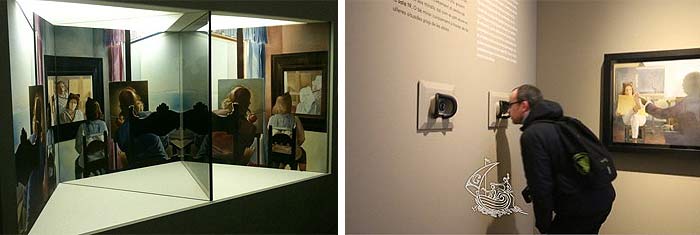
The Dali Foundation --- Theatre-Museum -- Figueres, 15 December 2016.
Early influences matter
"The catalyst for this line of investigation was the work of Gerrit Dou (1613-1675). At an exhibition in Paris between 1970 and 1971 that included work by the Dutch painter, Dalí discovered that Dou had made duplicates of his paintings. According to Antoni Pitxot, former director of the Theatre- Museum, Dalí was convinced that these were not just copies but that it was essential to view the pictures together. Studying them more closely, Dalí confirmed that they were not exactly the same, and that there were small differences between them."
( ... )
"After studying Dou’s work and stereoscopic techniques Dalí came to the conclusion that the Dutch painter had used special lenses and mirrors to create a single stereoscopic painting (probably with the help of Van Leeuwenhoek, one of the early developers of modern microscopy), and was thus the inventor of this technique."
( ... )
"Based on this principle, Dalí created pairs of paintings of almost identical images, but seen from different focal points in order to produce three-dimensional effects when viewed. To achieve a perfect relief effect, Dalí slightly shifted the centre of each image in relation to the viewer’s eyes; these pairs of paintings are therefore never identical copies. In fact, the colours of the images also change, sometimes very obviously."
"The resulting composition formed in our brains becomes an image in three dimensions, such as those that have been popularised today by virtual games and projections."
---------------------------------------------------
"At the Theatre-Museum, in room 19, there is a permanent display of photographs of some of Dalí’s stereoscopic works, staged with mirrors that allow the three-dimensional effect to be observed. In order to see the relief, one must simply bring one’s face close to the glass, at the centre of the edge of the two mirrors. In contrast, in room number 22, where we present this temporary exhibition, some devices have been installed next to each pair of stereoscopic works in order to see the three-dimensionality. These devices consist of special glasses and a mobile telephone screen, like those typically used in virtual reality projects. We have adapted the mechanisms that Dalí proposed in the 1970s to view his stereoscopic works to the 21st century." --- Figueres, 15 December 2016
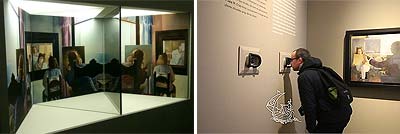
Exhibition of stereo paintings by Salvador Dali at the Theatre-Museum
Figueres, 15 December 2016.
"In room number 22 we present six pairs of stereoscopic oil paintings: Dalí from behind painting Gala from behind immortalized by six virtual corneas momentarily reflected in six real mirrors , c. 1972-73; Gala’s foot, c. 1975 - 76; Untitled. According to ‘Las Meninas’ by Velázquez, c. 1975-76; The structure of DNA, c. 1975-76; Dalí's hand drawing back the Golden Fleece in the form of a cloud to show Gala, completely nude, the dawn, very, very far away behind the sun , 1977-78; Dalí lifting the skin of the Mediterranean Sea to show Gala the birth of Venus, 1978."
On Exhibit:
Dali stereo paintings (paired canvases) from Dali Museum archives --- Anaglyph 3D recreations (from stereo pairs) by Al Razutis, use red-blue glasses
Dalí
from behind painting Gala immortalized by six virtual corneas
momentarily reflected in six real mirrors, c. 1972-73
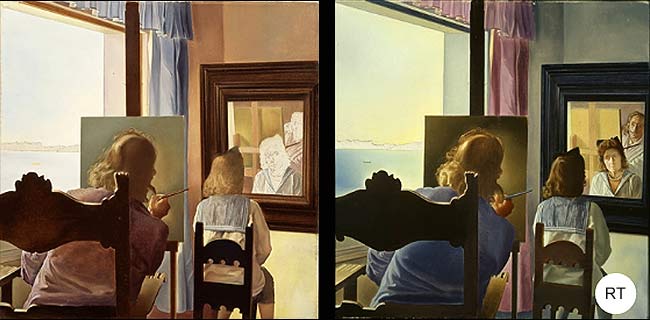
Red-Cyan Color anaglyph 3D view (assembled) by A.R.:
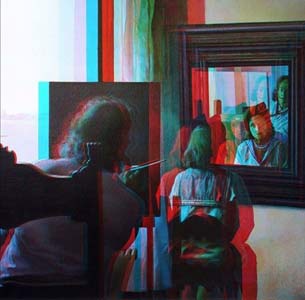
-----------------------------------------------------------
Gala's Foot, c. 1975-76

Red-Cyan Color anaglyph 3D view (assembled) by A.R.:
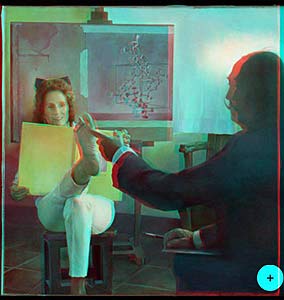
-----------------------------------------------------------
Untitled. According to ‘Las Meninas’ by Velázquez, c. 1975-76

Red-Cyan Color anaglyph 3D view (assembled) by A.R.:

-----------------------------------------------------------
The Structure of DNA, c. 1975-76

Red-Cyan B&W anaglyph 3D view (assembled) by A.R.:

-----------------------------------------------------------
Dalí's hand drawing back the Golden Fleece in the form of a cloud to show Gala, completely nude, the dawn, very, very far away behind the sun, c. 1977-78
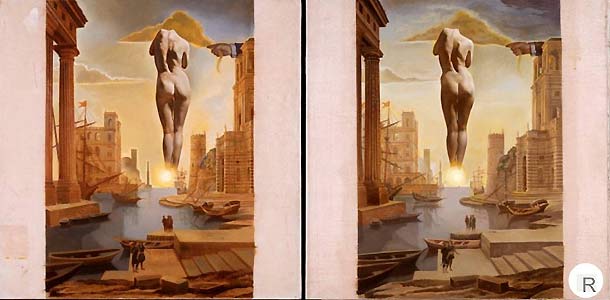
Red-Cyan color anaglyph 3D view (assembled) by A.R.:
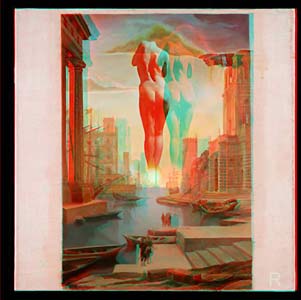
-----------------------------------------------------------
Dalí lifting the skin of the Mediterranean Sea to show Gala the birth of Venus, c. 1978

Red-Cyan color anaglyph 3D view (assembled) by A.R.:
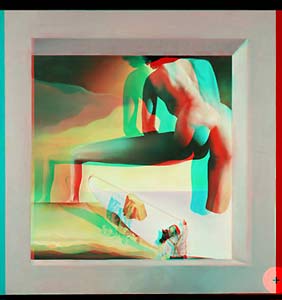
"It is abundantly clear that stereoscopic 3D 'happens only in the brain' employing the well-known 'stereopsis' that our minds use daily",
most everyone in 3D agrees...
"What is less known is how it all works with creative processes inducing or employing changes in our perception. And for that we need the arts, and the arts need space.
A recitation and analysis of some of Dali's formal stereo 3D strategies, as related to his ideas of surrealist disruption will follow next. If only to offset the impulse to describe such matters as perception, aesthetics, experience in mechanistic terms, or even worse, to use diagrams, and measurements to use diagrams, and measurements to explain oneself."
--- A.R.
4.1 Dalinian stereo
If you're an artist with the stature of Dali by the time you are seriously practicing stereoscopic experimental paintings (1970's) at an age (66) when most retire, you're only going to be taken seriously after many decades have passed. First will come the false gushers, the imitators, the wannabes, the poseurs dying to have a picture taken with the master, and make some money off it.
It's a lonely gig to be one of the 'first in show'.
But as long as you stay away from New York or Paris or London and hang in your coastal abode you can experiment to your heart's content as these paintings (on this page) exhibited in Figueres (2016) show.
What do they show?
They show Dali used a camera or optical imaging system to set or visualize compositions, and that he used floating windows, and floating images, where both orthoscopic and pseudoscopic image projecitons were sometimes present. He further made precise omissions or changes to details in one, but not the other, eye view to further confound the viewer's experience of it.
We experience 'stereoscopic 3D' in our minds as a product of 'stereopsis' and the ability of the mind to fuse left and right eye perspective views into one image and reality.
This means that Dali was at liberty to experiment with what each 'deformation' of perfect and identical views offset by the parallax of eye separation could accomplish. He could add and did add, and subtract details from each eye view to achive his proper level of 'confusion'. This means that Dali's stereo paintings could accomplish '3D visual effects' in the 1970's while no camera or film optical printing could do this, or ever showed it.
This was an era before any real 'digital graphics' except in government (MIT) funded programs, not like today where everything can be digitalized, manipulated, replaced and reconfigured pixel by pixel on any home computer.
But this was not about making 'special effects' or 'eye candy'. Not about Hollywood but all about 'being Dali!'. And being Dali was to be a surrealist, provocateur, adventurer, not a poseur for art magazines or fan clubs. Dali's experimental paintings created a new form of 'stereoscoic 3D art' as paintings on canvas, and that's a fairly undescribed and under-appreciated body of contempoary art.
------------- Page Top -------------
5.0 Towards a new interpretation of space-time in art
"In 1958 Dali wrote in his Anti-Matter Manifesto:
Today, the exterior world and that of physics has transcended the one of psychology. My father today is Dr. Heisenberg."
----- Salvador Dalí, Anti-Matter Manifesto, Carstairs Gallery, New York, December 1958 – January 1959,
quoted in ‘Nuclear mysticism’, Salvador Dalí: Liquid Desire, National Gallery of Victoria, Melbourne, 2009

'Melancholy Atomic' by Salvador Dali (1945) 'Galatea of the Spheres' Dali (1952)
'Soft Watch At Moment of First Explosion' Dali (c.1954)
AUTHOR'S NOTE: Quantum Mechanics and Particle Physics in the late 1950's and continuing through the 1970's were fairly well established sciences which many saw as working in tandem with military nuclear weapons establishments at the time around the world. Certainly, Dali (who was living in the USA post WWII until 1949) was affected by the 'cold war' politics and race for nuclear armament 'superiority' and this was seen in his art. Similarly, this author (A.R.) was educated in these disciplines at the post-grad level in the late 60's in the USA, and can ascertain the influence nuclear studies had over culture and society and politics of that 1960's era.
"The Disintegration of the Persistence of Memory (1954) by Dali harks back to The Persistence of Memory (1931)... in portraying that painting in fragmentation and disintegration has been interpreted as a reference to Heisenberg's quantum mechanics." [above source]
Earlier in Dali's career with the surrealists it was interior (psychic) space, dreamworld, dreamtime. Now, now with the 1958 manifesto it was atomic physics, particle physics, and a spacetime described by science as four dimensional, relativistic space where even time was maleable.
This change in focus between dreamworld, and physical space found a curious bride in stereoscopic paintings, which by definition and practice engage the subjective mind and 'stereopsis' to convey their subject, and which also by definition is bound to rules of human binocular sight and its geometric optics.
And then along came holographic theories, technologies and methods of creating 'spatial objects'.

In Search of the 4th Dimension by Salvador Dali 1979
To summarize this transition from Freud to Heisenberg, from stereo-paintings to holographics in Dali's art, is to place by quotation a few signposts here:
"Since his childhood Dalí had been fascinated by the Dutch painter Gerard Dou (1613–1675), whom he believed had been experimenting with stereoscopy, another form of optical illusion. The process ‘uses two almost identical pictures to generate a three-dimensional effect. The two pictures are brought together in a system of mirrors or prisms so that the viewer gets a spatial impression of the subject, just as human sight delivers’ " (Frank Weyers, Salvador Dalí, Life and Work, Könemann, Cologne, 2000, p. 86).
"In the 1970s the artist experimented with the technique himself, and some of the resulting stereoscopic paintings were based on photographs taken by his friend, the photographer Marc Lacroix, with a special camera."
----- Elliott H. King, ‘Dali and Science’, Salvador Dalí: Liquid Desire, National Gallery of Victoria, Melbourne, 2009,
----------------------------------------------------------
------------- Page Top -------------
5.1 Symmetry, Conjugates and Space
The mirror image and its surrealist 'ghosts'
To engage in a Rorschach test of mirroring images is a most appropriate beginning for the study of 'some Dali' and some surrealist films, as I did in my compilation - interpretation titled 'Ghost : Image' 1979 ( Visual Essay #4 ) from which these film frames are presented.
Showing what?
"Showing the 'ghosts' that live within the imagination, especially the 'paranoiac' who is sensitive to the appararitions that reside within every house of unimaginable delights which to some are 'horror!." (A.R.)
(I need not elaborate further, this is a trivial delight, but inscrutable to those without imagination or wonder.)
REFERENCE (one of many):
'Un Chien Andalou' / 'An Andalusian Dog' by Louis Bunuel, Salvador Dali (1929), on You Tube
The double image in Dalinian space
Let us contemplate what Dali means by 'paranoiac'
'Some beautiful examples of splitting and projection'
In 'non-stereoscopic Dalinian space' Dali shows us the method of his sanity which others call insanity
"In the previous paintings of Dali, we see a face appearing from within the landscape. The ‘Bust of Voltaire’ disappears behind the other people, while in the other paintings a face appears from within a mountain or a fruit disk. Here, the ‘endless enigma’ becomes an eternal expression of Dali’s talent to depict the effect of the double. It seems that reality has (at least) two sides, which appear altogether simultaneously. Since our brain cannot focus on two images at the same time, we are left with an impression of a deeper level of reality, composed by far more subtle interactions between things." --- Exploring the irrational: The paranoiac- critical method of Salvador Dali, Chris Tselentis (2014)
"In 'Dalinian stereoscopic space' the 'stereo windows' are shifting, the 'effigy poses no threat' as it hovers or engages in dance." (A.R.)
------------------------------------------------------
Stereoscopic paintings by Salvador Dali
-----------------------------------------------------------
Untitled. According to ‘Las Meninas’ by Velázquez, c. 1975-76

Red-Cyan Color anaglyph 3D view (assembled) by A.R.:

Where is the 'stereo window?' And where is the hand that draws, the eye that sees?
-----------------------------------------------------------
Dalí's hand drawing back the Golden Fleece in the form of a cloud to show Gala, completely nude, the dawn, very, very far away behind the sun, c. 1977-78

Red-Cyan color anaglyph 3D view (assembled) by A.R.:

Where is the 'effigy?' And where is the eye that sees?
-------------------------------------------------------
The stereo world of orthoscopic and pseudoscopic images
"That which is photographed or painted from one view only has no hope of revealing its sides, only following you in your meanderings'" (A.R.)
That includes 'phantograms'. Think about it.
----------------------------------------------------------------------
5.2 Holographic space and Dali
Conjugates: 'The mirrored twins of holographic space'
The best demonstration of 'holographic space' is a 'hologram' upon which such spatial information has been 'written' (explosed/developed, encoded, engraved), and in this presentation show directly the two mirrored elements of what are called 'conjugate images' (that are inverse of each other) named the 'orthoscopic' (virtual, but normal perspective) and 'pseudoscopic' (real, projecting, inverse perspective) images, the paired twins in this nursery, this space.
The following video should do the trick to illustrate this.
Video clip narrated by Razutis from 'Virtual Imaging, by Al Razutis 1997
- shown as stereoscopic analog video - You Tube
You can clearly see demonstrated the capacity of an image (and its 'space', or the space it occupies) be inverted, pulled 'inside out', where a concave image becomes convex, where background becomes foreground. A similar thing happens in stereoscopic photogrpahy or painting when the eye-wear glasses are reversed with the right eye and left eye changing places.
You can also see in the making of holograms, in the copying of holograms, the use of inverting the space again from 'pseudoscopic' to 'orthoscopic' to restore original parallax, or to project the images in space.
It is clear our perceptions (as in stereosocpic binocular viewing) and the conjugate images of 'holographic space' have a direct relationship and that they are maleable and in the hands of artists represent an aesthetic 'space'. It is also clear that the human psychology and perceptions are directly dependent on natural laws which govern the physics of this universe. Something acting completely 'against the natural laws' risks extinction in more ways than one.
So, is holographic space an illusion?
"Holographic space is merely the recorded, encoded version of properties of four-dimensional space-time. What is recorded is the amplitude and phase of any object within this 4D space. Its only limitation comes from the means of recording, encoding ('the measuring of') this space, using either (and preferably) analog methods or digital sampling and re-creations. Its 'reality' comes about when one properly illuminates the hologram' (either by laser, or white or filtered light, as is appropriate to the specific hologram) to recreate this space.
Therefore, the permanence of this space is entirely dependent on the 'recording and preserving medium'.
One can also conclude that holographic space only comes about (is manifested, rendered) under the right 'conditions', and it's appropriate here that these conditions involve electro-magnetic radiation (such as light) whose 'electro-magnetic force' (one of the four basic universal 'forces') underpin the 'existence of all matter'.
Now that's a concept to think about.
This term 'holographic space' has also become a marketing ploy, a label, a brand, tied to a 'commodity', a product. In this day and age, and capitalist culture, advertising and marketing have superseded facts and science, and there are numerous examples of faked 'holography' tied to stereoscopic 3D or VR, or even worse the projection of dead musicians on semi-transparent screens on large stages to fake the reality or the performance of it.
The most recent and egregious (in my view) conduct has been by Linda and Selwyn Lissack concerning their promotion of fictions in episodes where Selwyn claims to have 'introduced Salvador Dali to 'holographic space', to have 'collaborated' with him, and all by himself with the absence of others who are left out of his stories. And then they cashed in on these fictions at Sotheby's garnering hundreds of thousands for a postumous work ('attributed to Dali') which relies solely on their story as promoted in their self-published book 'Dali in Holographic Space'. Yes, that's coming.
But if you can't wait, and need a 'spoiler', here is a section that will get you going:
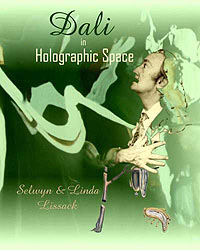
----------------------------------------------------------
To remember where physics and holography were at in the late 1960's - early 1970's:
'How Much for that Holo?' - 1970's display holography --- 2021 essay by Al Razutis
-----------------------------------------------------------
5.3 The Dali Holograms
"Dalí was one of the first artists to work with three-dimensional imaging or holography – a new medium discovered by physicist Dennis Gabor who was awarded a Nobel Prize for his research in 1971. The new technology was brought into being after the invention of the laser in 1960, which delivered a pure, stable light source ideal for creating holograms. In collaboration with specialised experts in the field, including Gabor, Dalí created a number of holographic images, notably two using Multiplex holography, a technique combining special lighting, cinematography and restricted movement on the part of subjects being filmed. The image produced by this method can be viewed three-dimensionally from all sides."
"The first involved the young performance artist and rock musician Alice Cooper. Dalí had attended some of the bizarre, often violent, theatrical performances staged by Cooper and his band, which featured gothic imagery, almost Dalinian in style, including fake blood, boa constrictors, baby dolls and guillotines. "
"The finished Alice Cooper ‘chronohologram’ (shown at New York’s Knoedler Gallery in April, 1973) revealed the bare-chested musician clad in exotic jewellery singing into a microphone resembling a segmented Venus de Milo statuette threaded along a glass rod – a symbol of American youth culture shattering past traditions."
----- Ted Gott, ‘Optical experiments’, Salvador Dalí: Liquid Desire, National Gallery of Victoria, Melbourne, 2009
You Tube clip of 'First Cylindric Chromo-Hologram Portrait of Alice Cooper's Brain' by Dali'
2 sections only - by XAR3D (Al Razutis) 2020
McCormack Collection & Archives copies -- two 'sections' from this classic 1973 hologram by Dali & Lissack & Cross. Film by A.R.
To read an extensive revue of this Alice Cooper multiplex hologram by Dali and the circumstances surrounding its creation:
'How Much for that Holo?' - 'Being Dali' --- 2021 essay by Al Razutis

------------------------------------------------------
"A second image employing the same technology... depicted Dalí in the act of painting a portrait of his wife Gala."
'Dali Painting Gala' by Salvador Dali (Salvador Dali, Selwyn Lissack, Lloyd Cross) 1976
View 2 min. video - 'Dali Painting Gala' multiplex hologram on You Tube narrated by A.R. 2020
------------------------------------------------------
To read more about the hologram 'Dali Painting Gala' by Salvador Dali, and the circumstances surrounding its creation:
'How Much for that Holo?' - 'Dali Painting Gala' --- 2021 essay by Al Razutis

-------------------------------------------------------
It is my conclusion that Mr. Lissack and others involved in the Dali holograms misunderstood the nature of Dali's explorations of perception and space. They misunderstood his surrelism and ignored his background in stereoscopic paintings. The resulting multilex hologram of 'Dali Painting Gala' only roughly reproduces Dali's original stereo painting 'Dali Painting Gala', and even features the original painting as a 'prop' in an otherwise cluttered composition which apparently was made to accommodate some limitations of the 'multiplex hologram' process then.
In the resulting two multiplex holograms there is little 'experimentation with space', with superimpositions, mirror images, with conjugate images. Except for a faithful reproduction of the scenes in 3D (horizontal parallax only!) in a miniature form, as a orthoscopic virtual image, nothing really unique happens here. There is the sarcastic proclamation (referring to Alice Cooper) when Dali famously said "He needs a brain!") and an attempted replay of a previous stereoscopic painting ('Dala Painting Gala').
Judging from the results (as per my video) in the holograms ('Alice Cooper's Brain' and 'Dali Painting Gala'), few of these inspired ideas of Dali, or his experimentaton with 'Dalinian Space' ever were realized either on film or in the multiplex holograms. The failures in each case can be attributed to the lack of experience, competence on the part of Selwyn Lissack who organized the shoots and then had the film printed by Lloyd Cross and multiplex printers. Upon completion, the installations, the compositions and final versions mirror all the other motion-picture multiplex scenes that were produced in the 1970's: a miniaturized rotating subject / character 'suspended in the center of the cylinder'. It is my conclusion that this (Lissack) version of 'holographic space' cannot be called 'Dalinian Space' and that Dali's work in holography was partially unsuccessful, incomplete, as these cylinder holograms show." (A. Razutis)
My views are partially supported by a San Francisco holographer Lon Moore who was present and in attendance with Lloyd Cross during this time of making these holograms for Dali. I quote him from a Face Book post of 2020 and my previous essay ('How Much For That Holo?', 2021) when he says the following:
"Lon Moore: Dali may have been the most famous, but those multiplexes were comically bad. We had quite a few laughs about them at the time. That probably didn't get into Selwyn's book either.
Hans Bjelkhagen: The value of an art piece depends mainly on who has created and signed it.
Lon Moore: One more thought on this... If Lloyd had written the book, Selwyn et al would have been mentioned as the sales guys and promoters that brought home the Dali bacon, thus allowing us to execute the technical feat that put Multiplex on the map. Personally, my feeling is that the real creativity in this project came from the technical end... In fact, there is no doubt in my mind about that."
REFERENCES:
Stereoscopic painting 'Dali Painting Gala''Dali Holograms in the Sharon McCormack Archives'
5.4 Shall we return to the basics and the operating table?
What is known and generally quoted:
Isidore-Lucien Ducasse (1846-1870) was a Uruguayan-born French poet who, under the pseudonym Comte de Lautréamont, published Les Chants de Maldoror in 1869.
( ... )
It was while reading Les Chants de Maldoror that French surrealist André Breton discovered the singular phrase that became foundational to the surrealist doctrine of objective chance:
This metaphor captures one of the most important principles of surrealist aesthetic: the enforced juxtaposition of two completely alien realities that challenges an observer's preconditioned perception of reality. German surrealist Max Ernst would also refer to Lautréamont's sewing machine and umbrella to define the structure of the surrealist painting as "a linking of two realities that by all appearances have nothing to link them, in a setting that by all appearances does not fit them."
-----------------------------------------------
"Lacking access to other subjects for dissection, the author (Al Razutis) here uses his own work to show you how it is done."
'The Dissection of '(Subject to) Time'
Featured here in 'anaglyph (red-cyan) stereoscopic 3D' as well as 'side by side stereopairs', and placed upon the 'operating table' is a sculpture, a construction, a 'hybrid' containing a very curious hologram, one that has 'captured motion', and 'captured time' in its shimmering breastplate of an image, which one can say 'stands in for the heart'.
'Subject To Time' is a creation of several components, an important aspect of which is the illumination (light) that reveals.
Reveals what?
Of prominent status is a pair of silvered bird wings which might suggest 'Mercury' (the messenger of the gods) to some, while to others it shows a pair of dessicated bird wings suspended in a box with a clear dichromate hologram front, a clear back, a wooden frame, with a handle, and two bobs (used by surveyors) dangling from chains...
Meaning what?
Meaning, we have a 'chance encounter' here, even if displayed publicly, or in an art gallery, or on a surrealist operating table, in a 'space' not a surface and not to exclude any dreams. It's very clear that the shimmering (gold) dichromate hologram contains a 'virtual image' of a 'bone-like object', resembling a 'bird breastplate', upon which are inscribed interference lines (interferometric contours) which clearly (clearly!) show that this breaksplate was captured 'in movement', in the interference between 'before' and 'after' (the interferometric contour lines) suggesting that this bird was once living and 'alive'...
Meaning also that we're doing art here, not just science. And certainly our 'biology dissection lab' course here has taken a surrealist turn.
What must be pointed out, without a technical explanation, is that the 'shadow of the bird wings' are clearly depicted on the back wall, while there is 'no shadow cast by the breastplate'... Yes, a solid looking image, created by reflection holography 'casts no shadow'.
And that is something to give pause, to think about.
Unless of course there is no 'room for surrealism or for poetry' in the reader who thinks they've ended up in a 'science course'... and in that case, they should depart quickly! Otherwise, they 'might get angry at the abuse of (their) reason', which is to say 'they have no heart that beats, only measuring devices, which are not of the surrealist kind'...
What is the back-story?
For that we have to go back to childhood, fascination with nature, and a bird's 'beating heart', which had to be cut out of the poor dead thing, and placed on the dissection table for all to see, then talk about. Well, all it took was one successful attempt at dissection that revealed to me that the 'heart' on a table is not the same as a beating heart... and so I dropped out of pre-med at the first appropriate occasion...
The other back-story concerns why this is also titled 'Stand in for Subject to Time' And this story concerns gifting this hologram art work to someone undeserving, and the presumption that the original work is now 'long gone'... only a stereo slide pair remains... And that means it was a foolish gift to someone 'without a heart', and should have never happened... (A.R.)
What are the credentials of the writer, critic, historian?
As good a time as any to state where the 'writer' of this essay (Al Razutis, A.R.) is 'coming from', and that is to acknowledge an extensive background in the 'making of holograms', the 'writing of histories and critical insights', plus an thorough background in the making of films, academic experience, and the building of technologies related to holography, film, video, stereoscopic 3D and VR multi-media... (my background is searchable, or for a brief summary see: www.alchemists.com/razutis-brief.html )
Web writings such as?
The following 2005 essay by Razutis answers some questions: 'Holographic 'Hybrids' and 'Surrogates' in the Art of Holography'

----------------------------------------------------
5.5 Speaking of statues, statues that speak!
Frames from the film 'Blood of a Poet' by the surrealist Jean Cocteau, 1930
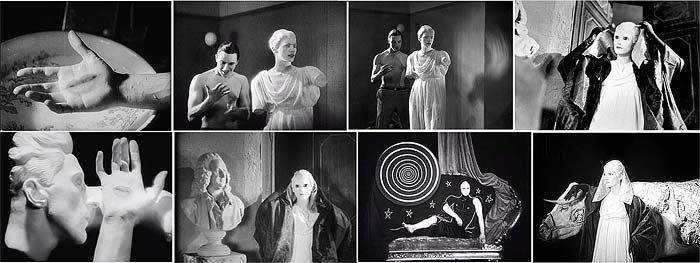
What is it about 'motion', 'motion pictures', even animation that make us pay attention? Is it about giving that inanimate object that 'gift', that 'breath', that 'life', which is to say and include the gift of movement and speech to make it human? And would that in itself suffice to explain the 'mystery of things'?
Oh, the Europeans and the surrealists really knew the art of incantation and 'the art of the uncanny'. ( "The feeling of the uncanny is created by the doubt if something is alive or dead. Freud was among the first to recognize the phenomenon in his 1919 essay 'The Uncanny.' He linked the sense of the uncanny with the existence of repressed feelings and thoughts which arise from the world of the unconscious as familiar images of forgotten things." --- Chris Tselentis )
This is certainly something I (also European) can relate to.
This will soon bring us back to the topic of 'holograms of living subjects' and 'holograms that move' (and are called multiplex holograms or integrals or even holographic stereograms). Yes, for some, motion is'everything'... as if a 'universe that moves' is a universe of 'life'... and only that which is 'real'?
----------------------------------------------------
5.6 'But first, let us borrow from visual alchemy:'
Literally borrowed from a closely related essay 'Alchemy, Visual Alchemy and their Respective Arts' (A.R. 2020)
"...and NOT to be confused with
"Dali and the phantoms that are of another place
or Plato's spelunking." (AR) ----- 'Plato's Cave and the Marvelous in Waiting'

|
"To give form to the formless, to animate the inanimate, to give it spirit" "To reiterate how psyche is projected into matter to arrive at an image, a sculpture, a moment of theatre: a psychic projection of human (antrhopomorphic) qualities into inanimate matter - to 'animate', to give it 'form', to give it 'spirit'" (AR) 'Autoportrait' hologram source: http://www.alchemists.com/visual_alchymyholo_visual.html#autoportrait Wood sculptures by Tung Ming-Chin 2013, 2019 source https://mymodernmet.com/tung-ming-chin-wood-sculpture/ (page 260) -- Psychology And Alchemy, C.G. Jung, 2nd Edition, pdf [ page number ] from this source: https://www.jungiananalysts.org.uk/wp-content/uploads/2018/07/C.-G.-Jung-Collected-Works-Volume-12_-Psychology-and-Alchemy.pdf 'Virtual Flesh' stereoscopic 3D film by Al Razutis 1996: https://www.alchemists.com/visual_alchemy/stereo.html#flesh Wood sculptures by Tung Ming-Chin source: https://mymodernmet.com/tung-ming-chin-wood-sculpture/ 3 min. selections from 'Virtual Flesh' in anaglyph 3D video:
ADDED NOTE: "I assert that this visual alchemy is not surrealism. It may contain common aspects, qualities, even elements, but the relationship between 'alchemy' (visual alchemy) and 'surrealism' is complex, and will be covered in some upcoming posts. "I make that comment for the simple reason that once this work was shown in a 'art gallery', to an 'art crowd' with 'art critics', it's place in society and culture was shifted to the aesthetics departments, to modernism, post-modernism, to the domain of philosophy and positivism, materialism, textual discourse, and the place of appropriated labels... like 'surrealism'... " ( A.R. ) |
----------------------------------------------------
6.0 Zoo stories - killing the goose for the eggs
It is my conclusion, and based on years of considering this question, that Salvador Dali's adventure, experimentation and works in the medium of holography were 'killed' by incompetent, greedy and self-promoting fools, primarily resident in NYC as part of the new 'holographic art' and 'holography is everything' culture that grew up there in the 1970's. Had he met and worked with other people, those who were more knowledgeable and experienced in art, especially Dali's art of surrealism, had they been more creative and less enamored with their 'magical medium toy', Dali's surrealism and his hologrpahic work would have turned out entirely differently.
Though these works by Dali are highly prized and significant, as is all work by Dali are, these holographic works are also informed by the invention of the multiplex or integral hologram, and printer by Lloyd Cross. The story of Cross and multiplex is told here.
The attraction of Dali to multiplex holography is clear from a surrealist perspective,: the 'uncanny animation' ('talking statues' in holographic movies) that would be possible! But in contrast Cross was primarly interested in obtaining a client for his new invention 'the multiplex printer Mark II', and financing his new operation at the School of Holography.
The two aims of Dali and Cross were related: 'to bring movies of living human subjects to the small holographic screen'. It is most unfortunate that they did not actually work together on these projects but relied on 'middlemen' who (in my opinion) made a mess of things.
Because of the stringent technical limitations of this holography medium in the 1970's ('special technologies'), because of the mystification and hype of this technology by some to their clients, and because of petty jealousies and greed for notoriety, riches and fame, these Dali multiplex holograms remain a testimonial to how one stream of surrealism -- the 'technical - optical - projected - phantasmagoric' -- ended up a partially disappointing holographic art failure, even if 'technically brilliant'. And it became an 'event', sometimes called a 'shit show', when celebrity and entertainment took over in that decade when Dali came to New York City to realize his holographic dreams. ( A.R. )
Shall we then take a walk in the park of speaking statues? And later drop in on ideas that expired before the paint was dry?
'And so we might conclude, now that we've come this far'
"The sole difference between myself and a madman is the fact that I am not mad!" -- Salvador Dali
"I’m not the clown! .... But in its naivety this monstrously cynical society does not see who is simply putting on a serious act the better to hide his madness. I cannot say it often enough: I am not mad. My clear-sightedness has acquired such sharpness and concentration that, in the whole of the century, there has been no more heroic or more astounding personality than me, and apart from Nietzsche (who finished by going mad, though) my equal will not be found in other centuries either. My painting proves it." -- Salvador Dali
6.1 The Alice Cooper holo that wasn't a goose at all
The first multiplex hologram by Salvador Dali was by way of a rock group comprised of ex art students named Alice Cooper, and this is 1972 and 1973, and the place is New York City. The hologram would be made in San Francisco. It began when Cooper band reps approached Dali to see if they could use one of his paintings for an album cover. Dali had a 'better idea': 'Why not make a hologram with Alice Cooper frontman bare-chested, wearing expensive jewelry and a tiara, sucking on a microphone thing with letters on it, mouthing something, to include something resembling a 'brain hovering' nearby?' And he would have to find someone to 'do this'.
You see, Dali had been thinking about this for some time, since his days with stereo paintings, and since Dennis Gabor received a Nobel Prize in physics in 1971 for the 'invention of holography'. The invention was in 1947. The laser was invented in 1960, but useful 3D imaging by holography only became feasible in the late 1960's. The 'white light multiplex or integral hologram' was invented in 1971-2 and perfected for display in 1973. It was the preferred means of making short 'holographic movies' of living subjects and was the technology of choice here.
"Anyone claiming differently is a flat out liar." ( A.R. )
And the reason this is posited here is that in this section we come upon plenty of 'impostors, liars, and thieves...' and their sycophants promoting it.
And it's been going on for decades now.
In the 1970's Dali was declining in health, getting into his late 60's, but he loved the idea of using some buff rock icon who acted crazy on stage, imitating 'surrealist performances', mixing and matching all genres, to 'shock rock!'. "He needs a brain!" Dali is quoted as saying after meeting the front man for the Alice Coooper band. Here, he declared, he had found the perfect 'subject' for his hologram, a pop version of a paranoiac playing 'talking statue'. That interpretation comes from this writer (A.R.). You'll have to read the rest.
A few years earlier, an entrepreneur ex-music promoter from South Africa named Selwyn Lissack had arrived in New York City and was cultivating Dali for all kinds of 'holographic projects' that were then created mainly by others for him and Dali. Later, decades later, Selwyn would write a book ('Dali in Holographic Space'), even deliver a paper to a science body SPIE, taking credit for everything, hardly ever mentioning anyone else along the way. This, on the road to 'selling at auction' some 'last Dali holograms' for big $ ($269.000). This is also is covered, analyzed, and some of it debunked here and below, because the history has to come with facts and witnesses, otherwise it is somebody's 'joke'.
"SYCOPHANT ALERT! Please notify any holo sycophant of this story of selling Dali, that they can finally see the facts roll in. This has been going on far too long to be funny." (A.R.)
Principal sources of information about this hologram, project, and who did what comes from a number of sources also some interviewed by this author (Razutis). These sources, also to include the Dali Foundation in Figueres, Spain, as cited in bold below.
To liberally quote from my page 'How Much for this Holo?' is to reveal what it was 'Being Dali' (essential reading) and to reveal what the makers and contributors to this work thought and said. For example:
6.2 The making of the hologram in the zoo surrounding it
|
'First Cylindric Chromo-Hologram Portrait of Alice Cooper's Brain' by Salvador Dali (1973)
What the press said about that day in New York, April 1973 when Dali met Alice Cooper:
'Alice Cooper Remembers His Encounter With Salvador Dali' PHOTOS: 'When Alice Cooper Met Salvador Dali in New York, 1973' (pictorial) SHORT VIDEO of the 'art scene / zoo': 'When Alice Cooper Met Salvador Dali in New York, 1973' (You Tube VIDEO) 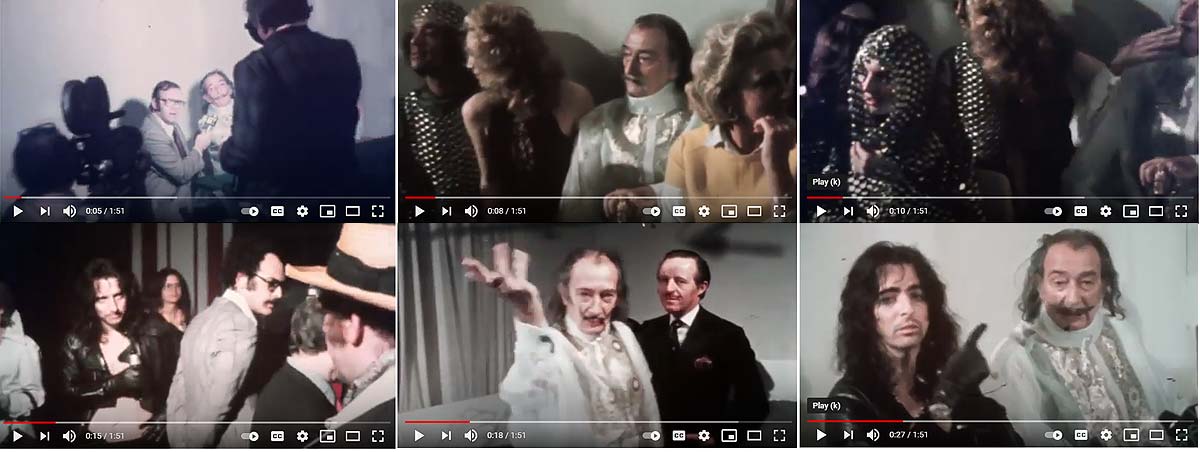
Each drama in the zoo comes with a back-story? Let the pictures tell the story. Another backstory provided by the competition who happened to be there A cinematographer associated with the Alice Cooper organization and working on promos for them Hart Perry was at the glam party where 'Salvador Dali met Alice Cooper' and where it was all 'for the press' and was 'fun'. Those following this story, to include the personalities in it, can benefit from this 40 minute video of this April 1973 event and press party: The 'Alice Cooper brain' hologram on video (video by Al Razutis)
You Tube clip of 'First Cylindric Chromo-Hologram Portrait of Alice Cooper's Brain' by Dali What Lloyd Cross, inventor of multiplex holography and maker of this hologram said:
What a witness to both New York and San Francisco actions said on the making of this hologram: February, 1973 "Suddenly the phone started ringing. It was 10:30 and huddled in candlelit darkness we looked at each other wondering who'd managed to get through. Lloyd answered and listened. He kept blinking and nodding his head affirmatively, until, in his soft-spoken way he said "Yeah... sure, it's possible. I designed the whole system in my mind.. when I was in New Mexico. But I need five hundred dollars to turn the power back on. I can't do anything without power." When Lloyd hung up his face was a beacon of joy and relief. "Salvador Dali wanted to make a hologram of Alice Cooper from movie film. The 16mm film would be shot in New York and processed in San Francisco. If his invention worked, if a multiplex laser camera, the Mark II printer, could turn ordinary motion picture film into a three-dimensional floating, moving image, Lloyd and his rainbow's end associates would have pioneered a viable commercial venue."
------------------- "They had thirty days to shoot the Alice Cooper footage and forty-five days to turn it into a hologram that would be unveiled at the Knoedler Gallery in Manhattan. "Few people, if any, could make an integral hologram in this short timeframe. The task entailed shooting the film in a specifically calibrated circular format and then shooting a holographic film from the original footage. In order to see the 3-D result, the image had to be reconstructed using a laser whose beam had been spread through the lens and positioned at an exact angle. Only a rogue genius physicist such as Lloyd Cross would be up for this challenge."
------------------- "Greenberg started to squirm. Lloyd told him that his creation of Alice Cooper was the lowest of the low and he didn't know if he even wanted to be connected with it. "Was Lloyd Crazy?! He was killing the deal. I couldn't stay silent on the sidelines. "'If he could promote Alice,' I blurted, 'he could promote anybody!'
"
-------------------- "Lloyd Cross, genius holographer, inventor of integral holography, was supposed to come back to N.Y.C. for a major press conference. He was several weeks late. It was Alice Cooper's manager who was putting up the money to launch integral holography. Lloyd didn't like the idea of a snake charmer sponsoring his pet project. And, ultimately, Lloyd blew the whole thing." --------------------- "That's where we are today (1974) in the world of HOLOGRAPHY. It's oh so bizarre to listen to Selwyn describe the multiplex process as his very own 'exclusive' process. 'There's one camera in the world...' 'Is there any competition?': '...ah, no.' And he shakes his head in a low profle manner allownig everyone to stare at the large brown-eyed man with hunched shoulders and a peeling sun tan, silently sighing, 'What a genius.'
"
Who was the cinematographer for the Dali first multiplex hologram?" Answer: "
Russell Beal was the cinematographer for the hologram shoot of Alice Cooper, the one used in the exhibited hologram to date, as per his recollections: What are the facts? The facts are that the Alice Cooper 'Brain' hologram was created under the direction of Salvador Dali, executive produced by Alice Cooper's manager Joe Greenberg, who put up the money, co-produced by Selwyn Lissack who set up the shoots, and co-produced by Lloyd Cross who handled all the holography and final creation of the holograms. The turntable film was filmed by Russell Beal, as confirmed in this account, and by Lissack himself in interview with Linda Law in 2021. (I use the term 'produced' and 'producer' in the usual film industry sense as to what producers do in productions. If someone claims to do 'everything', they better be prepared to prove it.) The facts also are that the Alice Cooper 'Brain' hologram shoots, as well as shoots for additional multiplex holograms of Dali and Cooper, were also contracted by Cooper's manager Joe Greenberg to another cinematographer Hart Perry (who was engaged then in making music-film promos for them). This information comes from Perry. Apparently the use of this other source would cut out Selwyn Lissack and could have been used (as film of subject on turntable) to make the final holograms by Lloyd Cross, and later by other multiplex companies. Instead, Selwyn Lissack arranged for his own cinematographer Russell Beal to shoot this (he told him he was financing this himself), and he cut Perry and ultimately Greenberg out of the 'Dali hologram' loop. Hart Perry answers some questions of who was tasked to shoot the Dali hologram films "I was hired by Joe Greenberg to shoot for him the first holographic movie with Alice Cooper and Salvador Dali. Ask Joe about this. ( ... ) "I was hired by Selwyn or Jody Burns to shoot the Dali and Gala hologram... I produced holograms from this footage on the Holographic Film Company multiplex machine but not for Dali. Dali asked us to produce other holograms for him. Ask Bill Molteni about this since he attended the meetings with Dali. Bill and I decided not to make holograms for Dali because it seemed unethical. He was Selwyn’s and Jody’s client. "Joe Greenberg, Selwyn and Jody deserve a lot of credit for producing the Dali shoots. They provided the money for Lloyd to make the multiplex machine.which he used to produce the hologram. Collier, Burkhardt and Lin had made stereograms at Bell Labs before this but it did not catch on. Even though Bell labs worked with artists like Stan Vanderbeek, they did not make the publicity that Dali generated. Lloyd helped further the interest in holography with his hologram, 'The Kiss'." --- Hart Perry, e-mail correspondence, 2021. That the other film shoots were done by Perry is confirmed by the videos he posted on the web: 'Film Clips of Dali, and Alice Cooper for multiplexing' -- by Hart Perry I will presume that Salvador Dali and Lloyd Cross never had a chance to see these other films by Perry and that they were only shown the 'Lissack - Beal' results by Lissack himself acting 'on behalf of Dali'. That the Perry shoots were done without close consultation with Lloyd Cross is evident from the lack of suitability for multiplex printing they displayed: they were filmed with a 'hand held' camera resulting in a vertical jitter unsuitable for multiplex; the framing and choreography and timing were not properly set; the shoots featured Alice wearing dark clothing which was a poor choice for the monochromnatic high contrast requirements for subjects, set, lighting, for holographic printing of multiplex holograms. This is unfortunate when you have a competent cinematographer put out of the loop by a producer who wants to control everything, and poor results or incompleted work show this. This turns up the other interesting fact: Selwyn Lissack apparently wanted to corner the market on Dali, act as the 'only Dali contact', be the 'only representative in holography for Dali', and in so doing wrecked this project with inferior work, exaggerated promises, lousy art direction, less than competent design and preparation for holography, and continues (to this date) to exclude Hart Perry or others from any mention on this or other holographic shoots featuring Dali. "As they say in the feature film industry, those who lowball everything then try to maximize their profits end up working in the parking lot." --- ( A.R. ) What did the people who made this hologram think? Lon Moore, who was there in SF and at multiplex and traveled with Lloyd Cross to NYC pretty much sums it up when he says: |
"In my view, Dali and his Alice Cooper project got screwed." --- ( A. R. )
------------------------------------
What is the name and place of the other essential reading on the Dali holograms?
'How Much for this Holo?' (Al Razutis, 2021) is where I reveal what it was like 'Being Dali'.
What are the limitations of white-light multiplex (integral) holograms?
The main limitations of white-light multiplex holograms in the 1970's are: there is no vertical parallax in the scene, only a horizontal parallax, meaning you can't 'look over and under' the objects in the scene, only horizontal parallax exists. This is because the originating information (film frames) are all 'two dimensional and rotating along a horizontal axis view'. Furthermore, the image is mostly 'transparent' (as it is a transmission hologram) and when one attempts to view it from another angle (height) it changes colors (!), which can be annoying for someone trying to see it in 'full three dimensions', not in the 'stereo 3D look'. Finally, the idea of 'holographic motion pictures' is a bit overblown. These holograms featured very limited motion and limited action due to the fact that 'time smear' had to be minimized and therefore everyting (the action) was done in extreme 'slow motion', hardly reproducing 'natural' time and space in the recordings.
----------------------------------------
6.3 'Dali Painting Gala' multiplex integral hologram
This was a more ambitious, and confusing undertaking, also claimed by many, as the story will be told. And as holograms go, it could have been 'better'... This would be the last hologram that Dali would make...
"And in my (author's) opinion, the choice of medium and multiplex holographic technique used was the wrong one for the subject matter and the spatial / perceptual paradoxes this work was hoping to reveal..." --- ( A.R. )
'Dali Painting Gala' by Salvador Dali (1976) , produced with Selwyn Lissack, filmed by Hart Perry - hologram by Lloyd Cross

'Dali Painting Gala' by Salvador Dali (Salvador Dali, Selwyn Lissack, Hart Perry) 1976
Multiplex hologram by Lloyd Cross -- SMC&A collection copies - 360 degree integral - video:
View 2 min. video - 'Dali Painting Gala' multiplex hologram on You Tube narrated by A.R. 2020
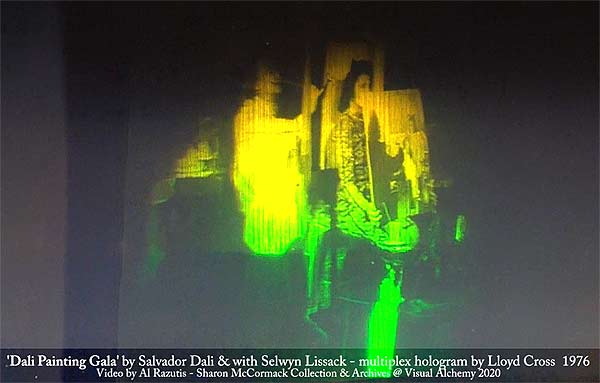
What this shoot and scene looked like on set and location:
... With people milling around, technical assistants, photographers everywhere, with everyone presumably having an opinion, but knowing their 'place' as you would on a 'Dali film shoot' or when any shoot of any pretensions is captured on video. In other words, everyone is either busy or looking serious.
Why this looks like 'preparing for a garage sale by a fading master' is anyone's guess. The footage was shot by a 'friend of Hart Perry' apparently on low resolution black and white half inch (Sony Port-a-Pak) video or similar 'camcorder' of our 1970's. It's the only documentation of this session and the author is grateful to Mr. Perry for making this available.
https://vimeo.com/376223999
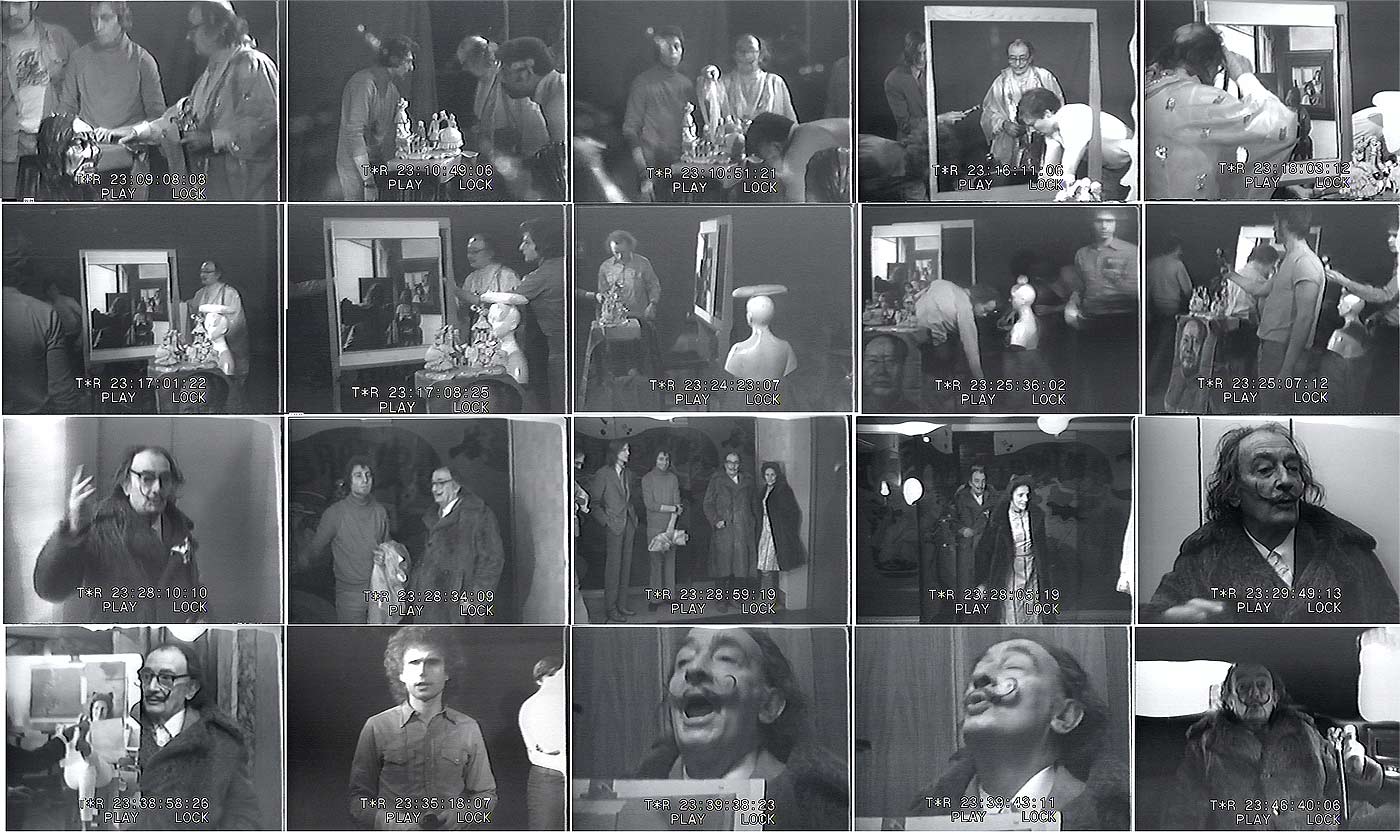
Enlarged picture in separate window
Dali Stereo paintings as comparison in stereo 3D
Dali stereo paintings (paired canvases) from Dali Museum archives --- Anaglyph 3D recreations (from stereo pairs) by Al Razutis, use red-blue glasses
Dalí
from behind painting Gala immortalized by six virtual corneas
momentarily reflected in six real mirrors, c. 1972-73

Red-Cyan Color anaglyph 3D view (assembled) by A.R.:

And on exhibit as stereo painting: 'Dali Painting Gala'
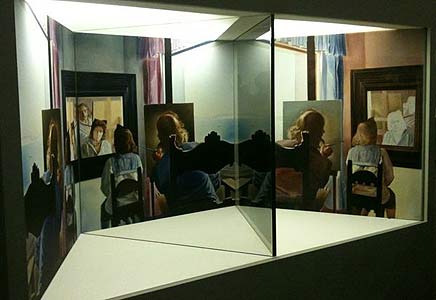
Installation views of stereo paintings (Dali Museum)
Dalí from the Back Painting Gala... by Salvador Dali 1972-73
Producer's eye-view retelling the holo story with embellishments:
Selwyn Lissack, is credited here as one of the producers of this hologram, and tells the story of this work and its design thusly in his book 'Dali in Holographic Space':
"Dali centered the hologram on an earlier work of a stereo optic image which he has painted of himself and Gala, from the back. The painting is externalized by six virtual corneas, reflected in six real mirrors, immortalizing Dali and Gala in three dimensional space. ( ... ) Dali wanted to be included in the hologram. The couple sat in the center of the turntable with this array of objects placed strategically around them. ( ... ) To give more dimensionality to the scene, Dali created the illusion of a cup and saucer floating in space in front of Gala." -- Dali in Holographic Space, Selwyn Lissack
No such cup and saucer appear 'floating in space in front of Gala' in the hologram. There is a cup and saucer among many of the object posed around the set. Mr. Lissack is now adding elements to the story not based on facts. Further, in his book and chapter on the subject, Lissack omits any mention of the cinematographer (Hart Perry) who shot the film of the set on the turntable with Gala and Dali, and omits mention of the holographer Lloyd Cross who made the hologram Lissack takes exclusive credit for.
Photo of set and description by Lissack --- Dali stereo painting (mono. view) of the same name

My (essay author's) comment on this second Dali multiplex is also for the record: "Mr. Lissack mis-states (in his book and SPIE paper) the meaning and the composition of the hologram, as regarding Dali's painting of the same name, Lissack mis-states that the hologram reproduces the 'pallet' of the painting or the 3D of the original stereo paintings -- see 'Dali Painting Gala' for comparisons. Is this important? It's one of the details that Lissack 'never gets right'. Furthermore, the multiplex hologram features the painting as a 'prop' in an otherwise cluttered composition, where Dali is seen in the midst of a clutter of objects and busts and is seen painting a seated Gala from the back and through a canvas. And she's holding a picture of the painting by Dali of the same name, not a 'mirror'. What that has to do with 'holographic space' is anyone's guess, except the obvious that this is a hologram of a 'space'. Few of these ideas of Dali, or his experimentaton with 'Dalinian Space' ever were realized in the resultant multiplex holograms that were produced.
The failures in each case can be attributed to the lack of experience, competence on the part of Lissack who organized the shoots, and then had the film printed by Lloyd Cross' new multiplex printer. Upon completion, the installations, the compositions and final versions all resemble the other motion-picture multiplex scenes that were produced in the 1970's featuring a miniaturized rotating subject / character 'suspended in the center of the cylinder'. There is no further 'interpretation' or 'synthesis' of space, only a mimetic reproduction of the scene that was assembled for the shoot. It is my conclusion that this (Lissack) version of 'holographic space' cannot be called 'Dalinian Space' and that Dali's work in holography was partially unsuccessful, incomplete, as these cylinder holograms show." (A. Razutis)
See the section on Dali's stereoscopic paintings 'Dali Painting Gala' for more insights into Dali's use of 3D.
MORE RESOURCE PAGES on the subjects of Dali multiplex holograms:
'Dali Holograms in the Sharon McCormack Archives'
'Multiplex hologram technology - what are they? How are they made?'

"The fact that we jump in time, and place, in the writing and with hyperlinks here is I think consistent with everyone's conception of holographic spacetime. And we are no longer inhabiting academic begin middle end here." --- ( A.R.)
------------- Page Top -------------
7.0 It's about time, isn't it?
This is where we tie in 5.0 Towards a new interpretation of space-time in art' (above on this page), with Heisenberg, space-time and Dali's Anti-Matter Manifesto, not to mention the 'disintegration of the persistence of memory' and all things 'Freud'... with the section titled 'Dali for Dollars!', from my 2021 essay 'How Much For That Holo?', and watch the truth shake out.

The Persistence of Memory (1931) ---- Disintegration of the Persistence of Memory (1954) ---- Soft Watch At Moment of First Explosion (1954) ---- In Search of the 4th Dimension (1979) by Salvador Dali --- click to enlarge
I place these references front and center here, not as a footnote. Time for a pause and to refresh our memories. And then let us see what happed to Dali posthumoustly, and check into his dying days ('to make sure he is dead?' or 'to prepare for the legacy laundromat?'). Either way we will end this journey fittingly.
The question of Dali's holographic works released posthumously
We can break down this inquiry to 'what was promised, but never delivered', 'what remains to be delivered', 'what was faked or forged', and in this case 'what was created and sold' under suspicious circumstances with a dubious provenance or outright misrepresentation.
I will certainly present the facts as I know them. The importance of closing our story guided by truth cannot be underestimated.
A word to the wise: there is 'nothing personal', no 'personal animosity' or 'personal history' between the author (A.R.) and the people described here. If there has been a professional relationship between the author and a vendor (as in the case of Ron Olson and the author in one project 14 years ago) it has little or nothing to do with the contents discussed here. This disclaimer is necessary to quell any 'rumor mill' and gossip which typically arises (and is perpetuated by malcontents) in small cultural scenes such as this.
What did Dali say about time and his interests in the subject?
Expressed as manifesto, as poetry, or paranioiac gestures. Certainly not written as a 'scientific' paper for the pathologists or physicists to examine for 'correct science'.
"In a conversation with Philippe Bern and Daniel Abadie, Salvador Dalí, in reply to the question "Do the scientists you meet always treat you as if you were mad?", said: "Quite the opposite, they all find me pleasant and say: 'Well, he doen't talk as much rubbish as it seemed'. My main advantage is that I don't know anything about anything, so I can give rein to my most capricious and irrational little whims on the basis of my light reading. And as I am blessed with a certain amount of genius, from time to time I say something that doesn't strike them as that improbable". --- Salvador Dalí and science, Carme Ruiz, Centre of Dalinian Studies. Gala-Salvador Dalí Foundation
"Dalí’s level of understanding of modern science is debated, but it is clear that his deep intuition allowed him to feel totally at ease in the company of scientists whose language was a constant source of inspiration to him. When Dalí died in 1989, books by Matila Ghyka, Erwin Schrödinger and Stephen Hawking were found by his bed." --- 'Dali and Science', National Gallery of Victoria, Australia.
I will continue with some quotations from a very useful source: 'Exploring the irrational: The paranoiac - critical method of Salvador Dali by Chris Telentis:
'Agony for space and time'
"Dali said that modern sciences were centered on the study of three aspects of life: the sexual instinct, the instinct of death, and the agony of space and time."
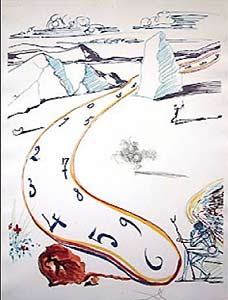
Melting Spacetime by Dali (1975 - 1976)
"Dali painted and sculptured many clocks to depict the 'agony of space and time.' The clocks are distorted as if melting, showing that time can be conquered, perhaps by just sitting on the beach of port Lligat in Spain on a warm summer day, watching oneself sweating to the point of dematerialization."
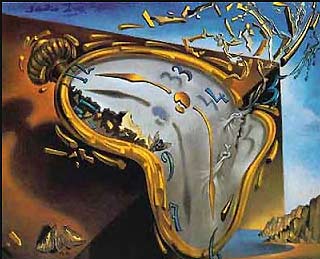
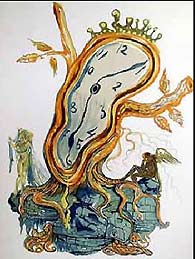
Soft Watch at Moment of First Explosion (1954) ---- Stillness of Time (1976)
"The clocks epitomize Dali’s theory of ‘softness’ and ‘hardness,’ which was central to his thinking at the time. As Dawn Ades wrote, 'The soft watches are an unconscious symbol of the relativity of space and time, a Surrealist meditation on the collapse of our notions of a fixed cosmic order.' This interpretation suggests that Dali was incorporating an understanding of the world introduced by Albert Einstein’s Special Theory of Relativity. However, asked by Ilya Prigogine whether this was in fact the case, Dali replied that the soft watches were not inspired by the theory of relativity, but by the surrealist perception of a Camembert cheese melting in the sun."

The Persistence of Memory (1931)
"The Persistence of Memory may be regarded as one of the most important paintings of the 20th century. Characteristic of the painting is the barren landscape, ideal to be filled with the surrealist objects. The creature lying at the center is a substitute for pleasure, exhausted by lust and the heat. Instead of a 'saddle' it has a clock on its back, and the melting clocks appear at different parts of the painting. This is a distortion of space and time caused by extreme heat. The ants, or insect- like creatures, on top of some clocks represent a sense of disorganization and annoyance in the midst of a hot Spanish summer, while the surrounding place is denoted by the white limestone rocks, typical of the Mediterranean landscape. The naked branch reminds of a long gone childhood, while the 'cabinet'’ and the 'platform' may be interpreted as supplements of reality and springboards to a new life."
"The painting could be interpreted in many different ways. Essentially, I believe that the painter dampens his own memories. He uses the most powerful weapon to soften the ‘hard’ everyday reality, and this weapon is heat. Someone could say that Dali discovered the ultimate weapon of thermodynamics to conquer space-time. Anyway, we should take into account that ‘heat’ is neither ‘hot’ nor ‘cold.’ It is just a form of energy which we experience one way or another."
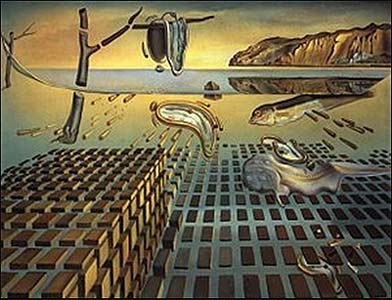
The Disintegration of the Persistence of Memory (1952 - 54)
"In this version, the landscape from the original work (The persistence of memory) has been flooded with water. Disintegration depicts what is occurring both above and below the water’s surface. The landscape of Cadaques is now hovering above the water. The plane and block from the original is now divided into brick-like shapes that float in relation to each other, with nothing binding them. These represent the breakdown of matter into atoms, a revelation in the age of quantum mechanics. Behind the bricks, the horns receding into the distance symbolize atomic missiles, highlighting that despite cosmic order, humanity could bring about its own destruction. The dead olive tree from which the soft watch hangs has also begun to break apart. The hands of the watches float above their dials, with several conical objects floating in parallel formations encircling the watches. A fourth melting watch has been added. The distorted human visage from the original painting is beginning to morph into another of the strange fish floating above it. To Dali, however, the fish was a symbol of life.
"One way or the other, either by persistence or by forgetfulness, we will never forget. There are the fixed objects and notions which surround and compose ourselves and our sense about reality. No matter how much we distort or deform them, they remain the same things, even viewed by a different perceptive. Einstein said that time is relative, but this relativity is found on both sides. One sees the other one being distorted, but from either one’s own perspective nothing changes. Therefore the persistence of memory comes from the hard core of existence, the essence that always remains stable and unchanged."
Source: 'Exploring the irrational: The paranoiac - critical method of Salvador Dali by Chris Telentis:
------------- Page Top -------------
----------------------------------------------------------
"Let us go then, you and I,
When the evening is spread out against the sky
Like a patient etherized upon a table..."
--- 'The Love Song of J. Alfred Prufrock, T.S. Eliot, 1920
----------------------------------------------------------
7.1 'Bring in the subject for re-examination'
As a patient etherized upon a table?
The 'Melting Clock' (2003)
As recorded and listed in Sothebys Auction Catalog:
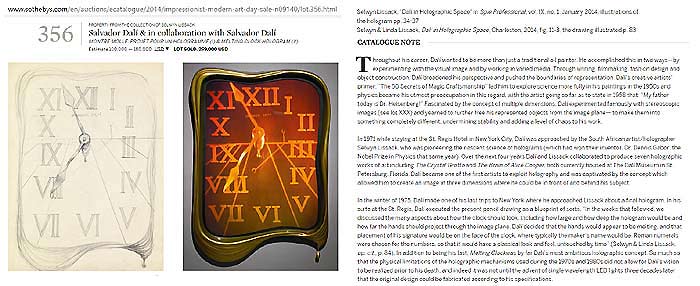
Selling price: $269,000 U.S.D.
(click on thumbnail for enlarged view to read text)
Supporting book 'Dali in Holographic Space' (2014), and SPIE paper (2014) by Selwyn Lissack, seller:

(click on thumbnail for enlarged view for reading text)
To read SPIE paper -- URL: https://spie.org/news/spie-professional-magazine-archive/2014-january/dali-in-holographic-space
The way this sales pitch begins is to set up the reader with false praise for the maker(s) of these works, and hyperbole that attempts to invoke the authenticity of science and its Nobel Prize in physics as a base for attaching itself to those achievements:
"To understand the dynamics of Salvador Dali’s great achievements in holography, which led to the n-dimensional moment of rock star Alice Cooper’s brain floating in a volumetric holographic space, hearken back to the 1940s when the idea of coherent interference came to be." --- 'Dali in Holographic Space, SPIE proceedings, 2014 Selwyn Lissack.
'Not a Dali?
A 'knee jerk rection' from the author might give away the end... presented as an example of contrasting styles of critical discourse:
"Well, this stuff from Lissack is flat out BUNK, there are no 'great achievements' by Dali 'in holography' except for some early hologram experiments, some partially unsatisfactory multiplex holograms; there is no 'n-dimensional moment of rock star Alice Cooper's brain floating in a volumetric holographic space' and it does not 'hearken back' (to Gabor and his invention of holography), except in Selwyn Lissack's own 'brain' which has yet to show in writing that it comprehends 'holography'... "
"SHAME on SPIE for publishing this Lissack paper without any proper peer revue (!)" --- ( A.R. as posted on FaceBook, 2021) -- reference to paper: https://spie.org/news/spie-professional-magazine-archive/2014-january/dali-in-holographic-space
An imagined response would go something like this: "Mister Razutis, we'll rule you out of order on this! If only for your 'tone', which some people here find 'belligerent' or at least 'hostile'. Please tone it down a bit next time so we all can get along in beautiful Pythagorean holo-new-age-harmony?"
"O.k., I will tone down the dialectic and 'conflict', I can see it is 'upsetting' of the status quo, which by the way stinks around here. Yes, you can delete that last part too."
"Thank you, your readers will appreciate a more moderate tone. It will be more convincing."
"That's what I mean. Regarding who you want to convince. When drama, when poetry, when hyperbole are chased out of the conversation, what we have left on the table is a clean looking 'stiff'..."
---------------------------------------------------------------------
"Bring in the subject and place it on the table"

'Melting Clock' by Selwyn Lissack with hologram created by Ron Olson, Laser Reflections, Las Vegas, 2003,
purporting to be an unfinished work by Dali from 1976, whose pencil drawing as conveyed to Lissack is the source and the 'authority'.
Bring in the witnesses, of which there are only one? In the form of a book by the seller, and his accomplices, which we believe are called by other names in art.
"I have a better idea. Let's do a forensic analysis and compare facts with the seller's story, his witness statements, and bring in any poetry to bear comment, if needed." (A.R.)
1. Can you judge a book by its cover?
Mr. Lissack never explains what he means by the term 'holographic space' so we are left to our own interpretation, depending on our knowledge base and familiarity with holography. "Is 'holographic space' the space recorded by the hologram? And if so, is it only specific to a hologram and the technique used to record it? And what of all the holograms that Lissack refers to in his list of Dali holograms, to include simple transmission holograms (the early ones), pulsed laser holograms made up of multiple layers (the card game), or multiplex (integral) holograms that were used to capture different subjects like 'Alice Cooper' and 'Dali Painting Gala'? What of a 'space' that is created or described via cylindrical lens projection of each motion-picture (flat) frame, projected by Lloyd Cross' aerial image holographic printers to make a cylindrical multiplex Dali hologram?
"To conflate or treat as the 'same' a hologram recorded (holographic) 'space' done with classical split-beam holography (a transmission hologram) which displays parallax in both vertical and horizontal viewing with that of a multiplex hologram that operates via 'stereopsis' (where 'depth perception is created in the brain from stereo views / frames) and features no vertical parallax is absurd and miseleading on the part of Lissack."
"I would further contend that the term 'holographic space' used here is meaningless unless defined, which Lissack avoids in his book, preferring to suggest (as I interpret it he does) that 'everyone knows what he's talking about anyways'. I, however, take issue with such sloppy labels which might sell books for 'Sel' (that's his nickname), but are otherwise useless." --- ( A.R. -- who happens to be the writer).
2. Can you judge a book by its back cover?
Not only 'introduced' to holography but 'Dali was waiting for him', according to Mr. Lissacks recounting of their first meeting -- "Ah, but of course, I have been expecting your call, can you come to the hotel tonight?", the 'we were destined to mee' type talk by the witness (page 9 of his book), when Mr. Lissack handed his phone to a friend to 'call Dali'... (because he explains he had a bad South African accent). Only to a sycophant ('true believer') would find that this Lissack narrative makes sense, except as a sales pitch.
According to other sources, Dali discovered (and was 'introduced to') holography was by hearing about the it when it became world news, when the Nobel Prize in Physics awarded in 1971 to Dennis Gabor for inventing holography in 1947. Gabor became a celebrity scientist for a while in the 1970's. Everybody wanted to know about this new magical 3D medium. However, in Lissack'b book the credit belongs to Mr. Lissack who credits himself for introducing Dali to holography and also becoming his sole 'collaborator'.
3. A pantheon of greats to include Lissack.
A screenshot from a page in 'Dali in Holographic Space' by Lissack showing himself included in the pantheon of inventors and greats in his version of the 'timeline of holography'. This is a self-published book. One can naturally make excuses that it never hurts to inflate one's reputation when selling, but why be so brazen about it.
While the first generation of art holographers (beginning in the 70's, and to include this writer) might know who was creating works, improving on holography in the 1960's and 1970's (and this and related texts by me are full of links to such subjects), the next generations might have 'no clue' and rely on authors like Mr. Lissack to set the record straight, which he doesn't. I am reminded of Lissack's fierce defense by some sycophants (Bob Hess is noted in previous examples) on FaceBook. who I also note were nowhere near any holograms or holography in the 1970's. This problem is not only generational but pertains to who reads what and why they come to the defense of their friends, who are 'nobodies'.
4. Lissack's book story of the melting clock holo has problems with facts right from the beginning.
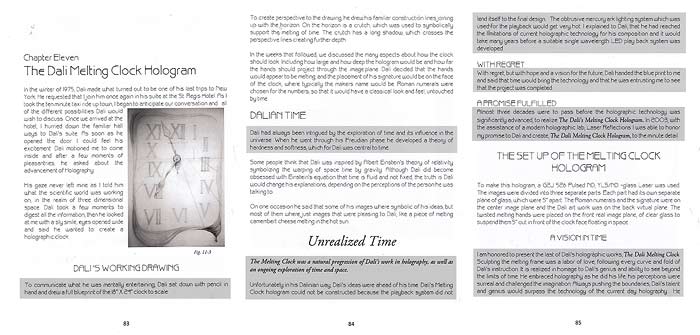
(click image to enlarge)
To examine each paragraph individually click on thumbnail to see the pages enlarged in a separate window.
The 1975 St. Regis hotel 'drawing' of this work could have been done by 'anybody'...
The sole witness to this account, as told in his book story (see page screenshot above) is Mr. Lissack.
"To communicate what he was mentally entertaining, Dali sat down with pencil in hand and drew a full blueprint of the 18" x 24" clock to scale. " ( Fig. 11-3 )
"Dali decided that the hands would appear to be melting, and the placement of his signature would be on the face of the clock, where typically the makers name would be. Roman numerals were chosen for the numbers, so that it would have a classical look and feel, untouched by time." --- Selwyn Lissack, 'Dali in Holographic Space' (2014), pages 83-84, Amazon Books.
We either take Lissack's word for it, or seek corroboration elsewhere (the Dalinian Institute, Figueres), whose archives I have searched, but alas have found 'nothing'.
The three decade delay in 'realizing this work' is in itself suspicious, and the technical reasons given are bogus.
Lissack explains this delay in this way, which contradicts the facts as I summarize later.
"Unfortunately in his Dalinian way, Dali's ideas were ahead of his time. Dali's Melting Clock hologram could not be constructed because the playback system did not lend itself to the final design. The obtrusive mercury ark lighting system which was used for the playback would get very hot. I explained to Dali, that he had reached the limitations of current hologrpahic technology for his composition and it would take many years before a suitable single wavelength LED playback system was developed."
"With regred, but with hope and a vision for the future, Dali handed the blue print to me and said that time would bing the technology and that he was entrusting me to see that the project was completed."
"Almost three decades were to pass before the holographic technology was significantly advanced, to realize The Dali's Melting Clock Hologram. In 2003, with the assistance of a modern holographic lab, Laser Reflections I was able to honor my promise to Dali and create, The Dali Melting Clock Hologram. to the minute detail." --- Selwyn Lissack, 'Dali in Holographic Space' (2014), pages 84-85, Amazon Books.
Lissack's account and description of 'existing holographic technology' (in 1975, the date of his purported conversation with Dali) is pure BUNK, meaning it is incorrect, and bordering on ignorance if not a purposeful misdirection. 'Mercury ark' (arc) lighting was no longer used for laser illuminated transmission holography by then, except in rare exhibition instances (for very large transmission holograms). These three-color (amber-green-blue) lamps were not 'hot' as Lissack suggests but in shielded glass containers and were useless for the image-plane reflection holography that Lissack chose to use. The added important point here is that a white-light-reflection hologram (illuminated by point source white light, or filtered white light) of the kind Lissack had created in 2003 were commonplace in exhibitions in 1975, even in New York City where Lissack was based then. Even this author (Razutis) had exhibited such holograms using white light in the 1970's.
A good example of bright image-plane colored white-light reflection holograms could be found in the works (in the mid-70's) of the holographic artist Lon Moore, whose reflection image-plane holograms were very popular and even sold at the Museum of Holography NYC gift shop... This is the same format of holography Selwyn Lissack chose to use in his 'Dali Melting Clock' hologram.
Here is a panel of holograms / images from Lon Moore's exhibited holograms (as this panel is featured in the section on Moore in the essay 'How Much For That Holo?':
'What about those single-frequency LEDs necessary for the hologram that Selwyn Lissack refers to in 1975?
"I explained to Dali, that he had reached the limitations of current holographic technology for his composition and it would take many years before a suitable single wavelength LED play back system was developed." --- Selwyn Lissack, pg 85, 'Dali in Holographic Space'.
While the LED light was not invented in the 1970's, it did not mark a major breakthrough for lighting white-light (or filtered light) image plane reflection holography. There is no 'single frequency LED' except that of a diode laser, which is useless for reflection image-plane holography. It became used in illumination, including reflection holograms in the 2000 era. The author (Razutis) first saw these colored LED's demonstrated by Ron Olson in Las Vegas, and he purhcased some of these lamps from him for tests. Their output is low, it is highly filtered light, and they don't represent much of an improvement over white-light LED or other white-light point source lamps. This issue is a red herring.
This brings up some points that I wish to make here: In my views Lissack demonstrated incompetence in his technical understanding of holography, in his description of the state of technology of making and exhibiting holograms. His own words are completely inaccurate, a fiction. For the described subject matter, there was no need to use a pulsed laser of the kind Lissack employed at Ron Olson's Las Vegas studio in 2004 to make this Dali clock hologram. Dali would have done much better if he has 'collaborated with' or commissioned his 'last hologram' with someone like Lon Moore who had proven competence, not Lissack who by his descriptions, explanations, and results displayed no suchy competence.
'The frame, the frame... it's all in the presentation, isn't it?'
Who came up with this design of frame to include in this work. Dali? The art deco design ( see above ) is totally 'out of character' with any other Dali 'clock paintings' (from the same time period, as described previously on this page). It is inconsistent with a 'Dali clock' to have such a 'deco' frame surrounding an otherwise rectangular area (the hologram) where verything else is 'not soft', not bending...
Such frames as Lissack used are commonplace these days as 'fake Dali', created as 'kitsch art' in typically 'Chinese factories' and sold for cheap prices on E-Bay. For example:

Dali in 'kitsch clocks' on E-bay, screenshot sample. Click to enlarge separately.
Who signed this work, anyway?
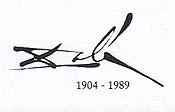
This is an 'authentic Dali signature' as cited in Lissack's book page 87.
Is the signature on the holographic clock authentic, or is it generic? It does not resemble this signature. By all appearances, it could also have been made and signed 'in China'... but by Lissack's account these were made 'in America'.
Where are the 'melting hands' that Dali purportedly called for?
The clock hands depicted in the hologram are certainly not 'melting'.
'Exactly done as per instructions?
The deviation from the purported 'instructions' is repeated in a number of details, prompting this author to say 'this is another idea!'. The numerals, the angles, the layout is close to the drawing, but not exact. It has been re-drawn or re designed to 'fit the technology' available to Ron Olson, who is credited in making this hologram at his lab in Las Vegas 2004.
'This is not a Dali, but a Lissack'
This hologram and frame does not appear to be 'by Dali'.
Foisted on the art market and sold for a cool 269K $... And years after the excitement waned, another batch ('by Dali') was offered by none other than Ron Olson, the guy who made the 'melting clock' hologram which sold for high auction prices:
"I am the custodian of (4) holographic transmission masters produced in a collaboration between Salvador Dali and Selwyn Lissack. There are (3) others in Selwyn’s possession: one is a small transmission master and (2) are digital conversions produced on 35mm film."
"The seven image collection is being offered by Selwyn for $350k and I am looking to see if there is interest in assembling a group to purchase the collection with the goal of exposing the public to holography through museum displays and (optimistically) producing limited editions that would be offered for sale through a major gallery. It would be my hope to use the revenue generated to begin funding the much-discussed and long-overdue “Museum of Holography” beta version." --- Ron Olson, posting on FaceBook group 'Holography', 2021.
Conclusion:
This was a missed opportunity for Dali, for holographic art to work with the right formats and to work with competent artisans and artists. This examination has proven that there are some important contradictions between what is described as being 'by Dali' and the circumstances of how and why this last work was made, according to what are stated as 'Dali's intentions'. Sometimes it takes a holographer to know the difference. Curators and historians without any background in this field can be fooled easily.
For more on the Dali holograms and the making, marketing, exploiting:
'How Much For That Holo?' - focus on Dali
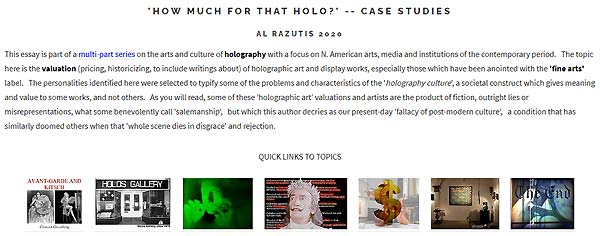
-------------------------------------------
In progress --- to be continued
-----------------------------------------------------------
------------- Page Top -------------
VISUAL
ALCHEMY & WORKS on FACEBOOK
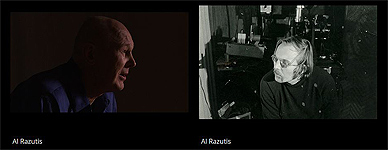
HOME PAGE:
Al
Razutis - Visual Alchemy WEB SITE


